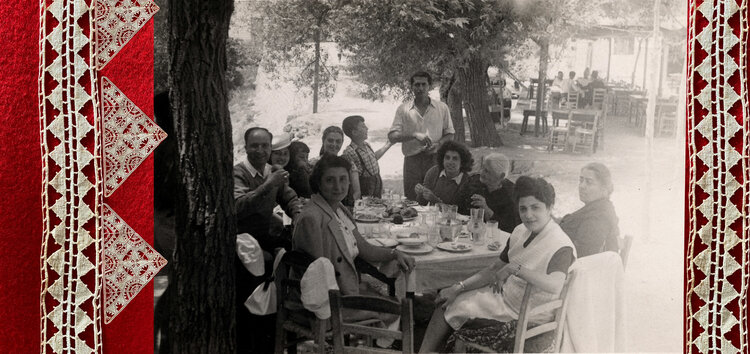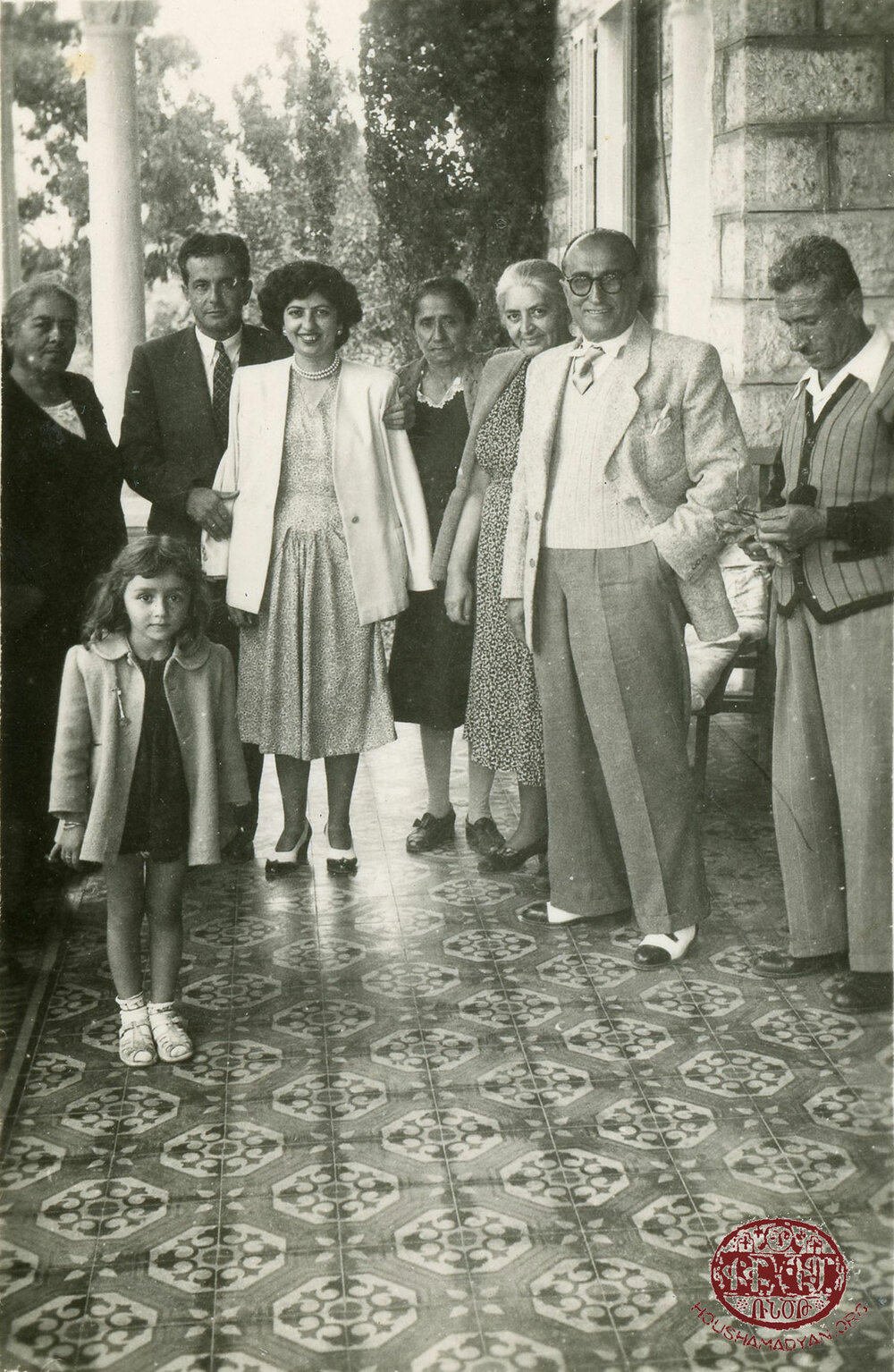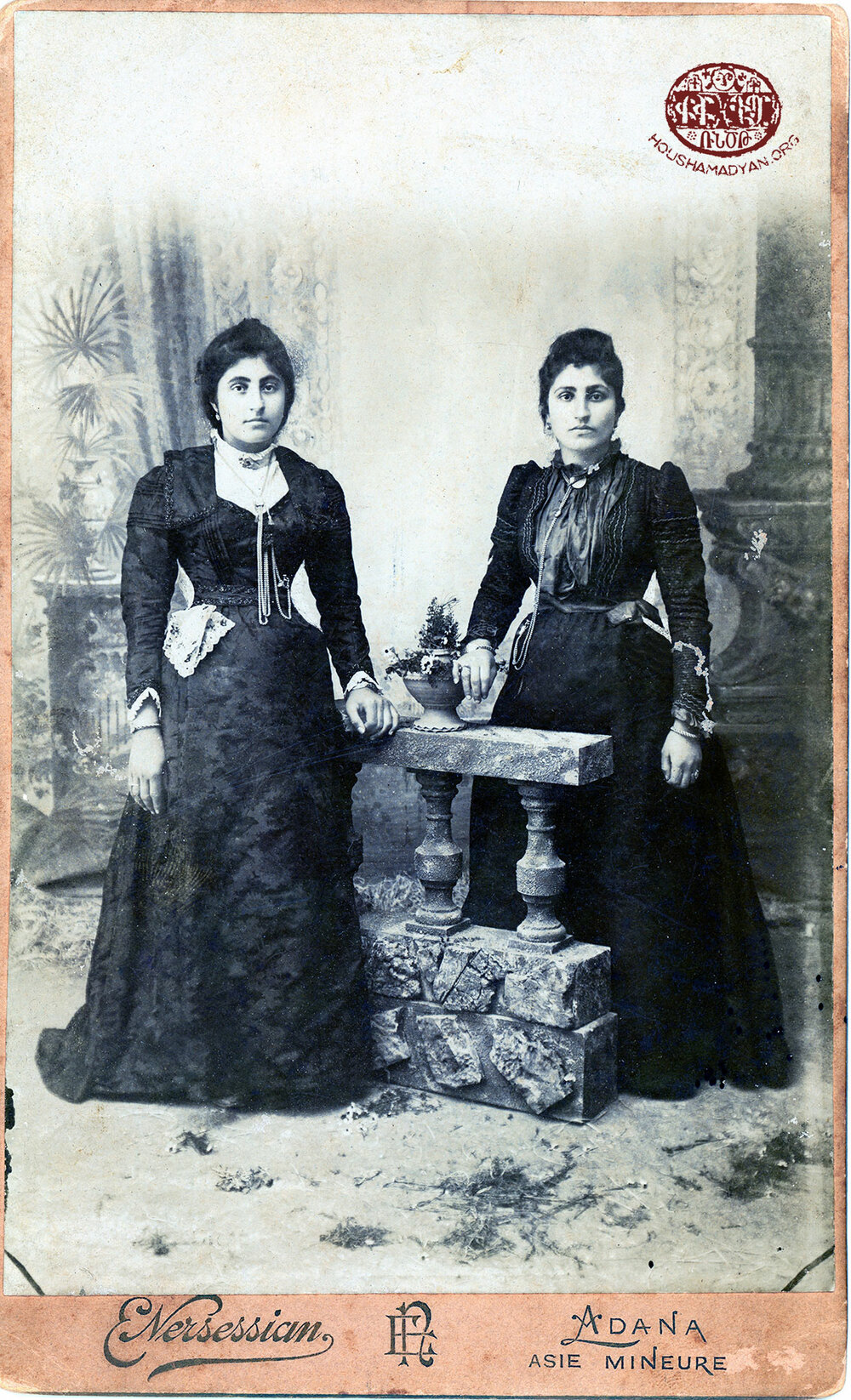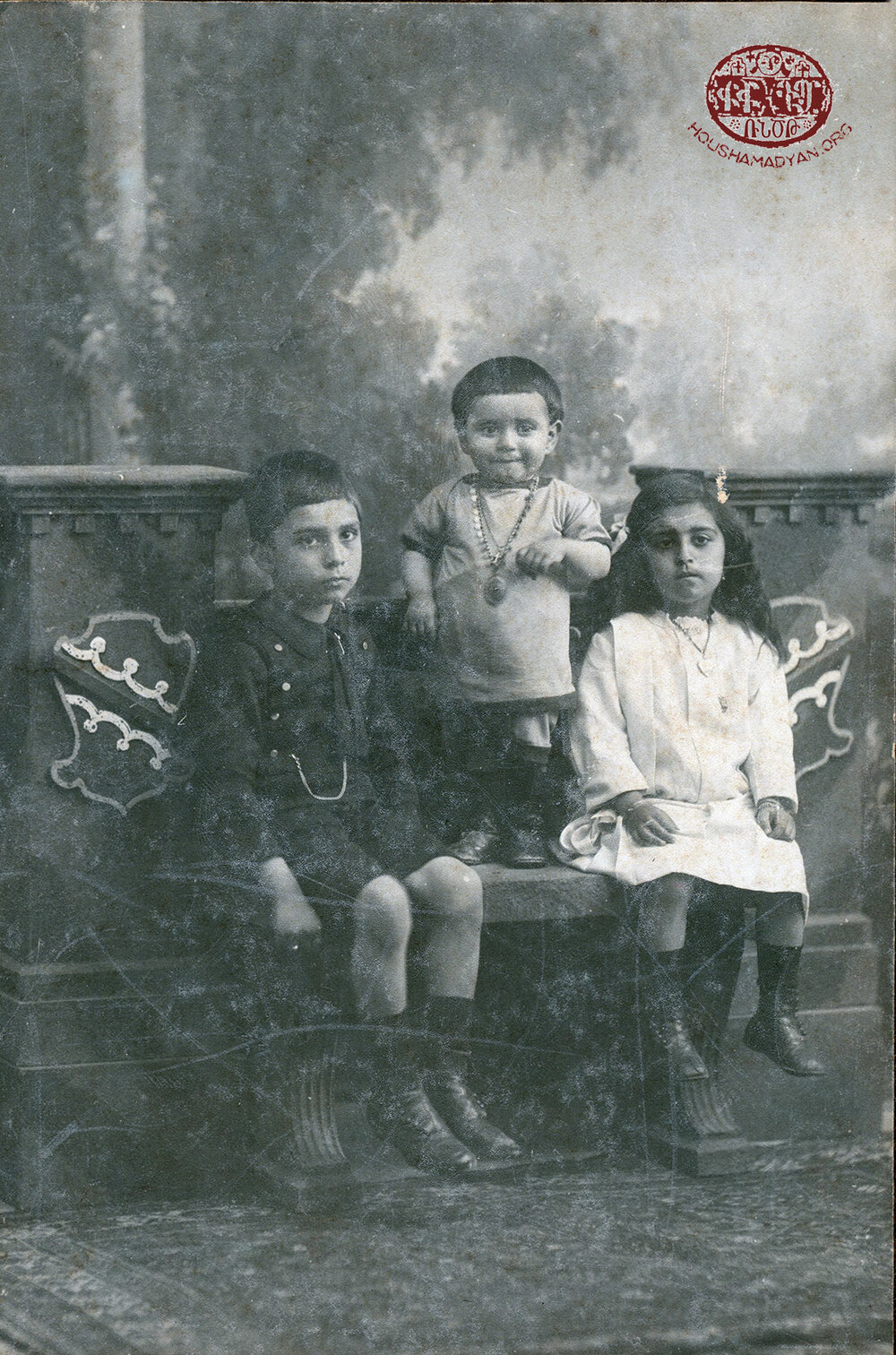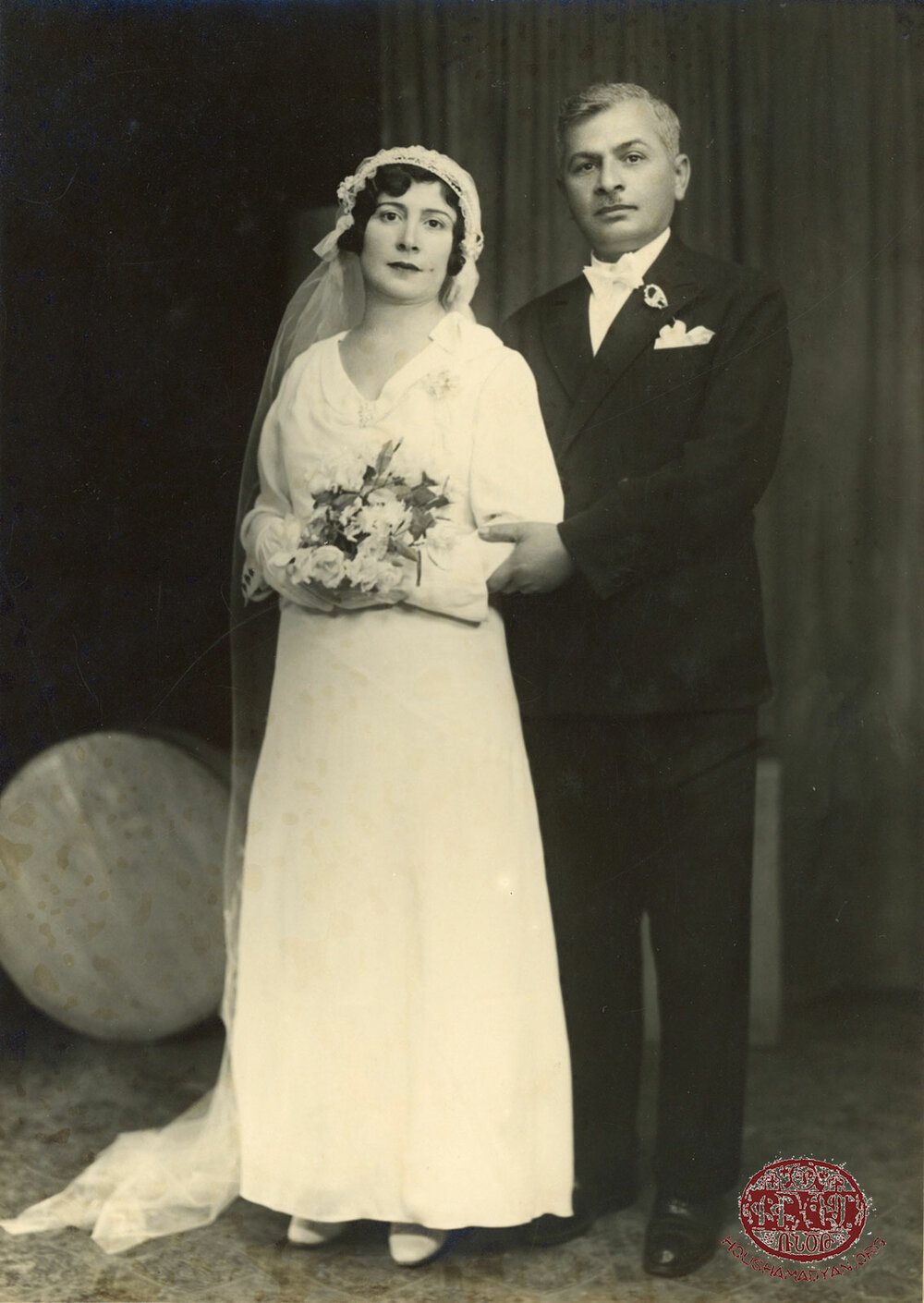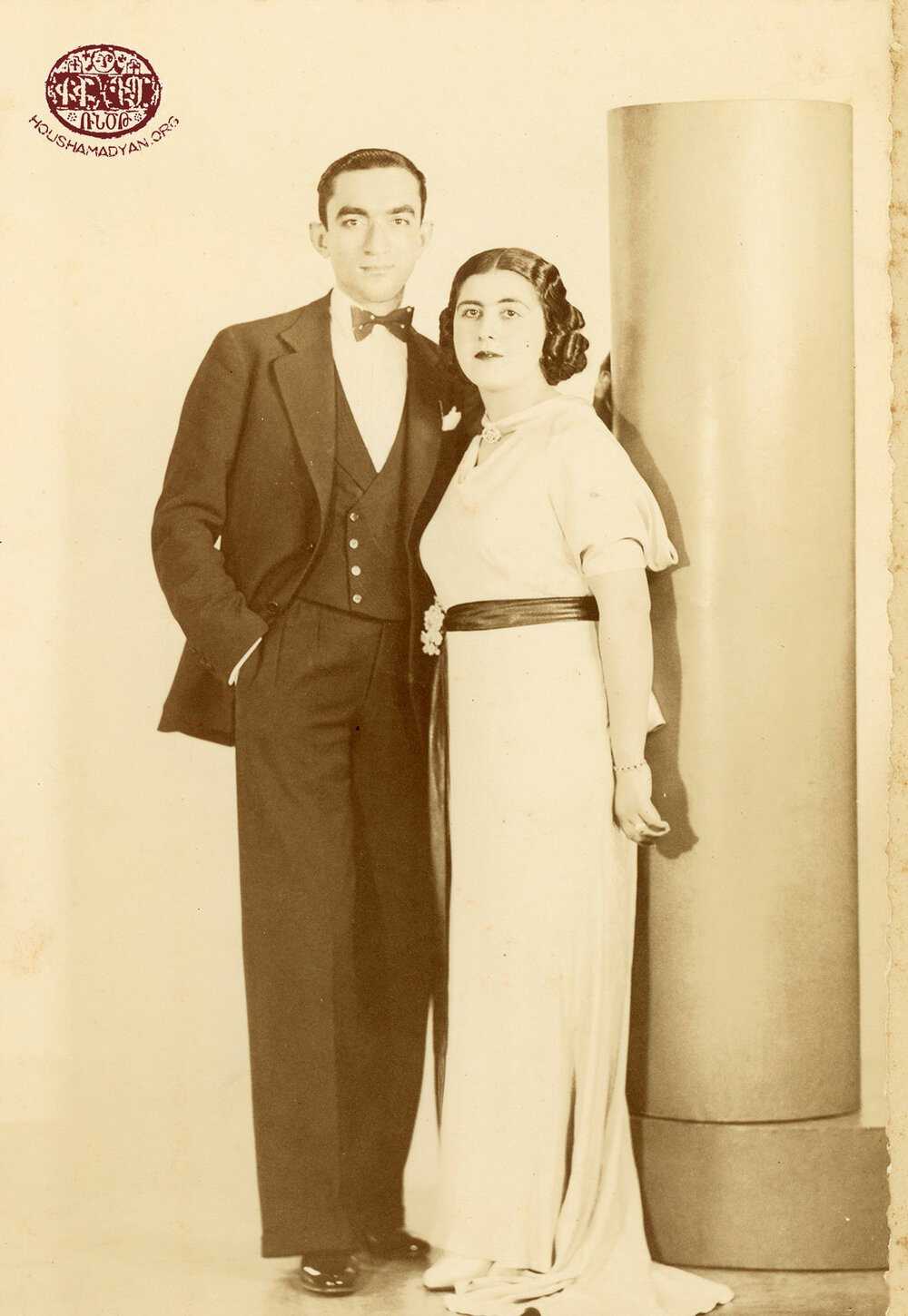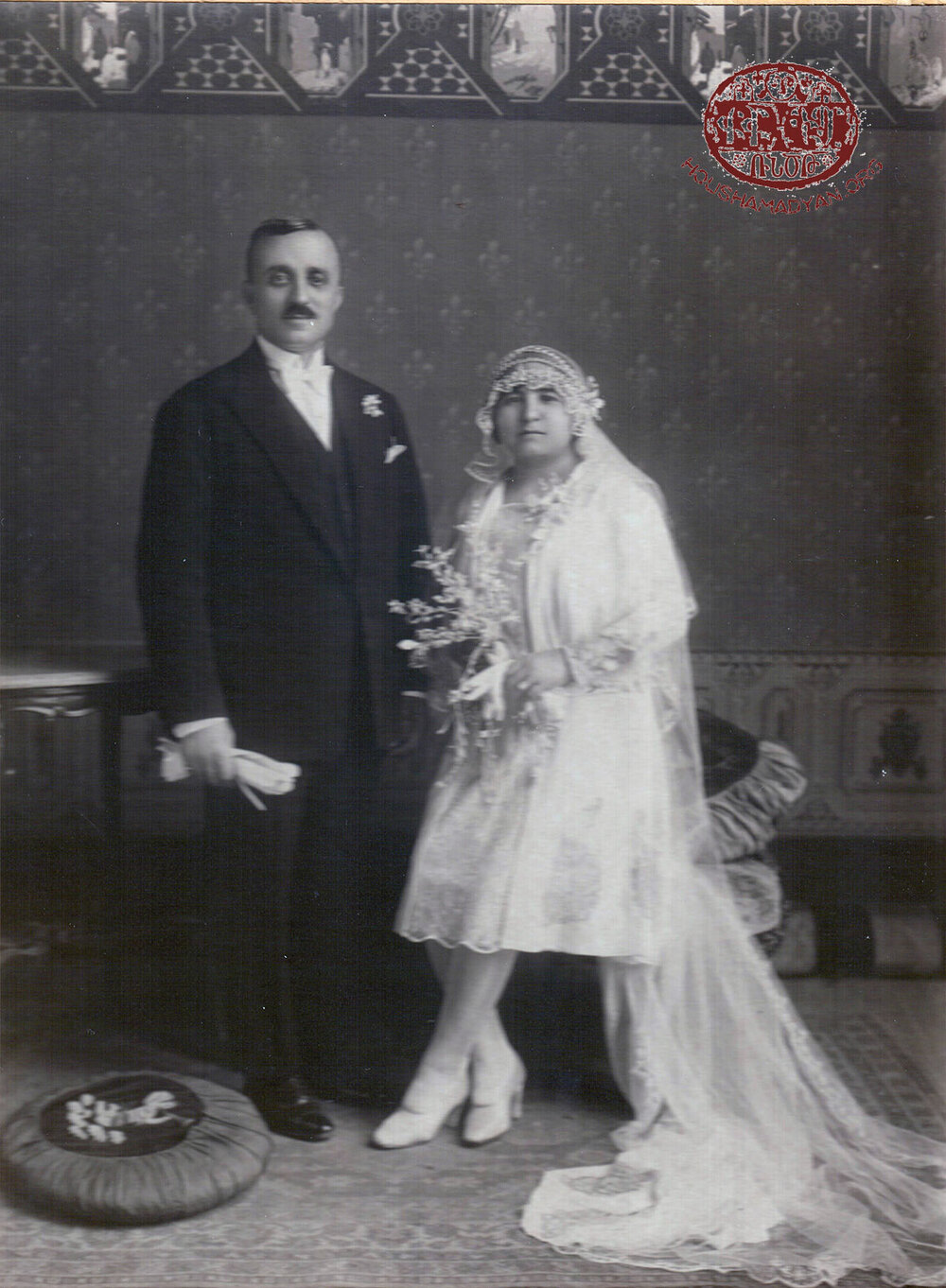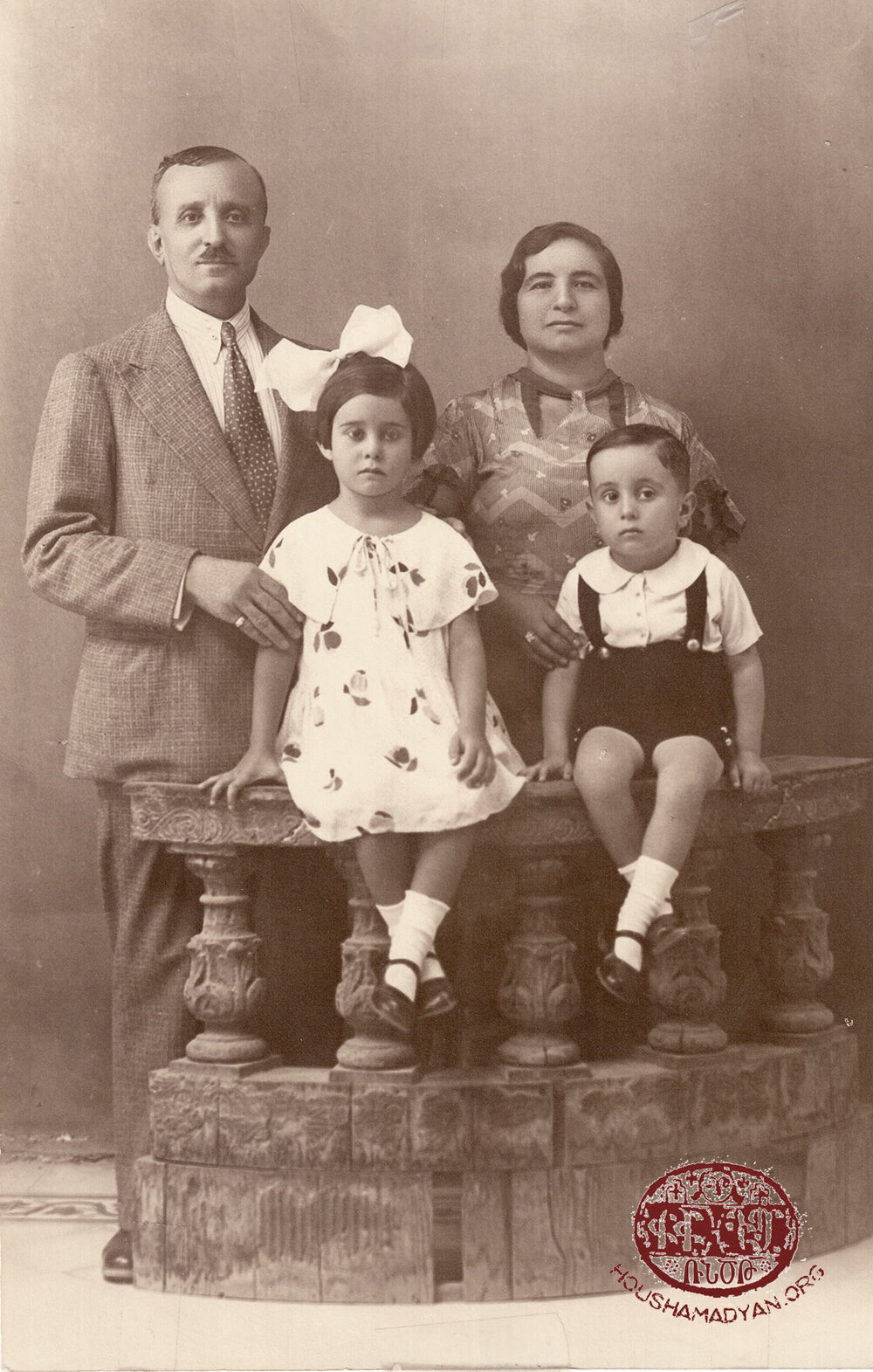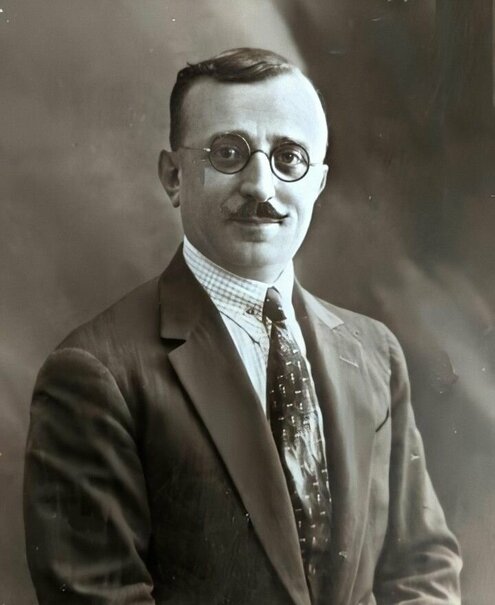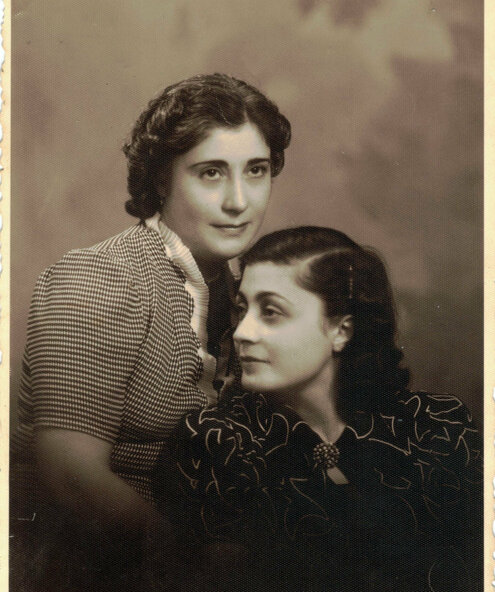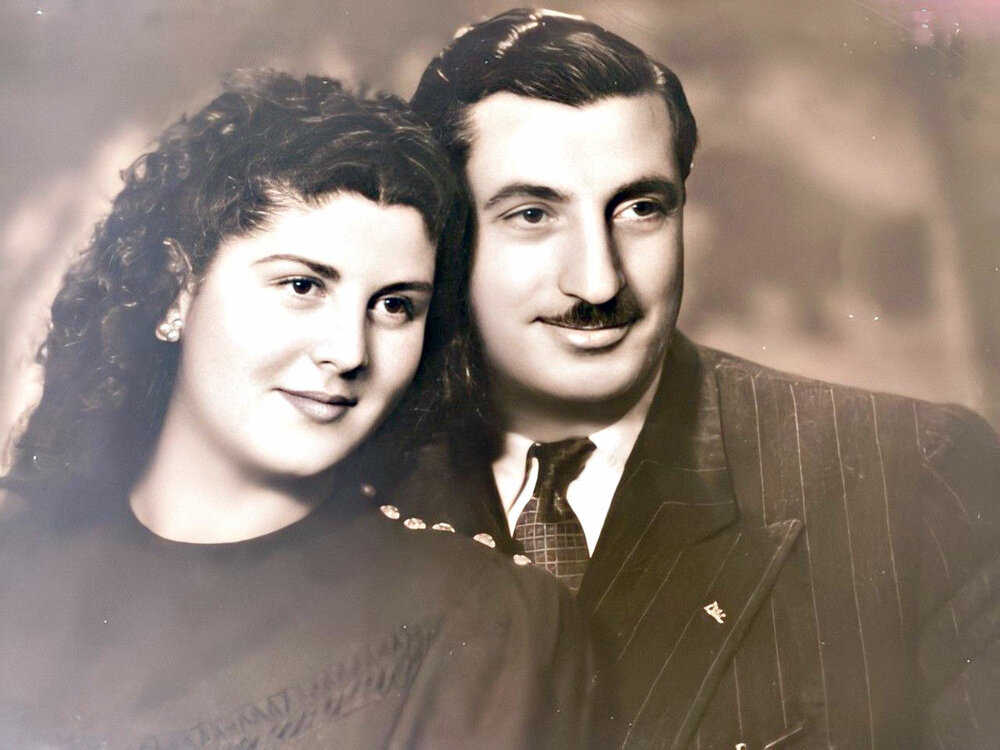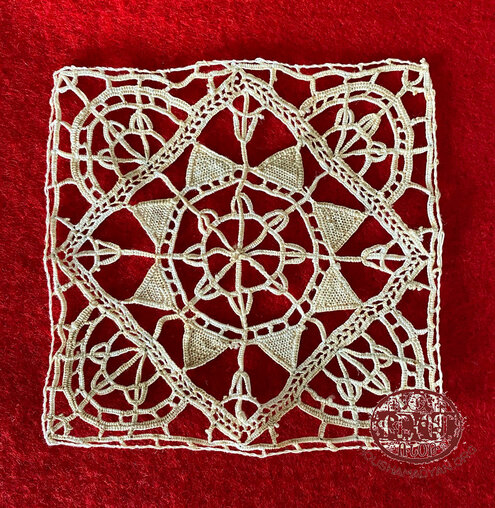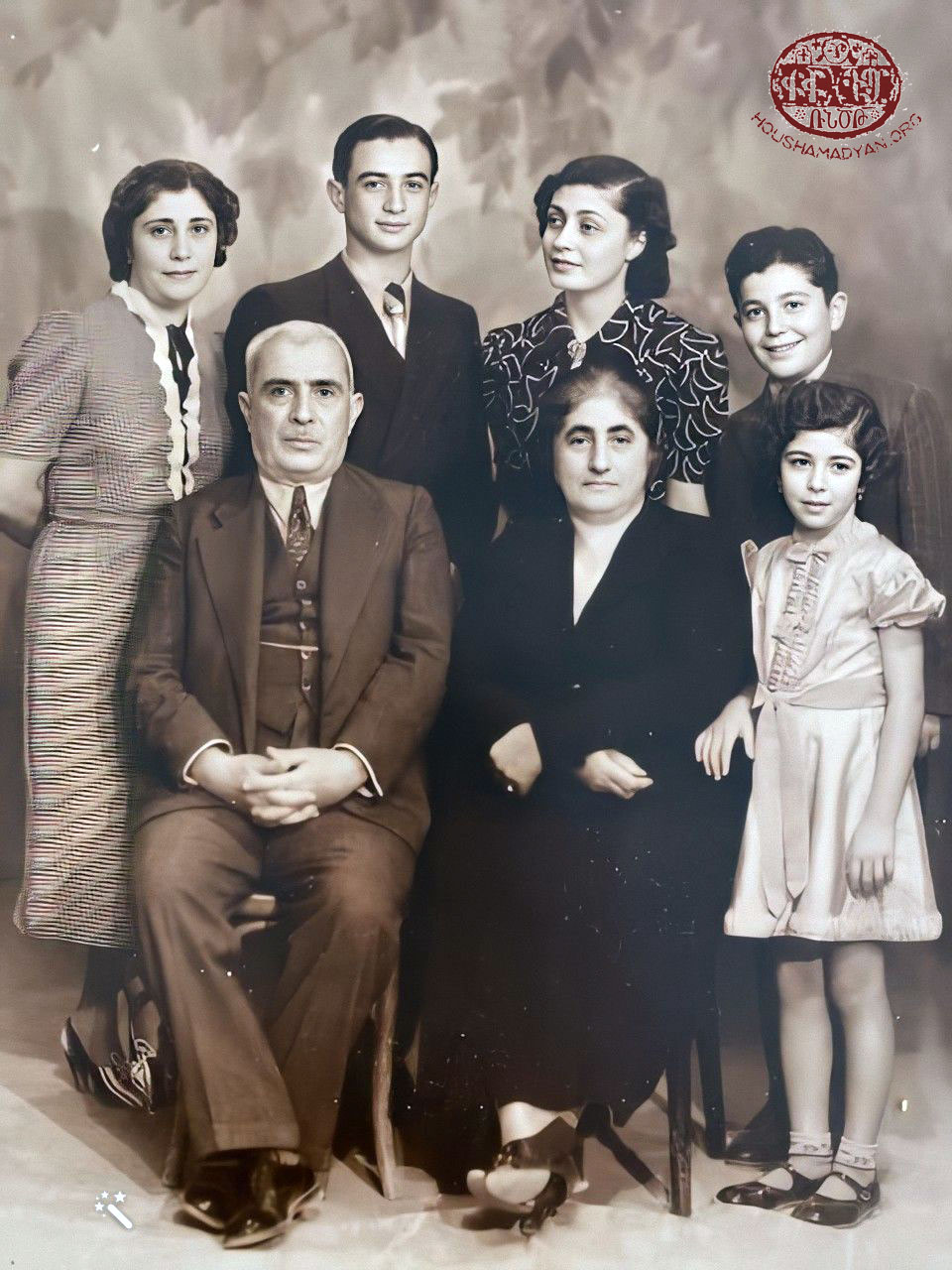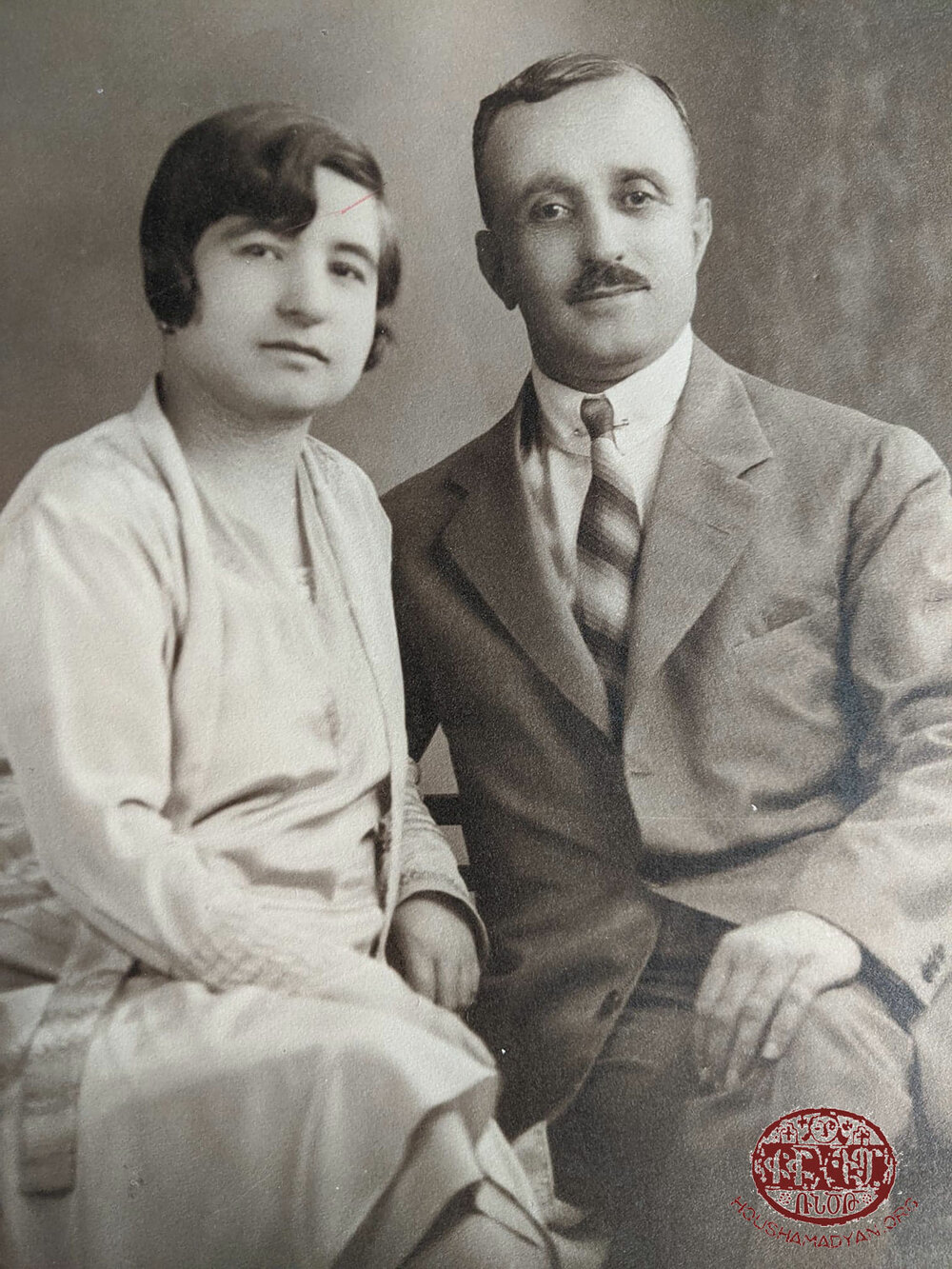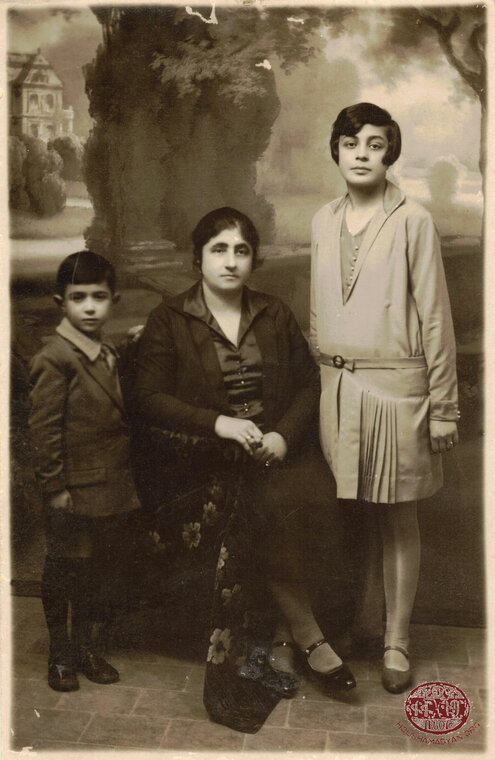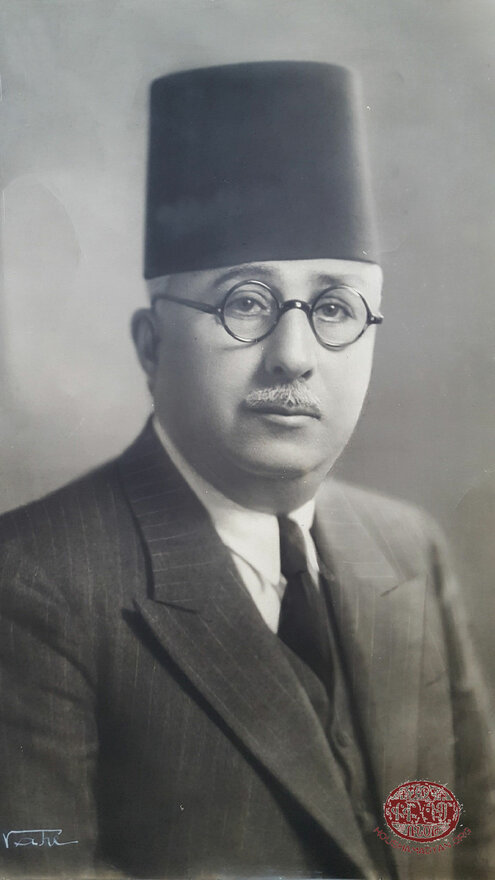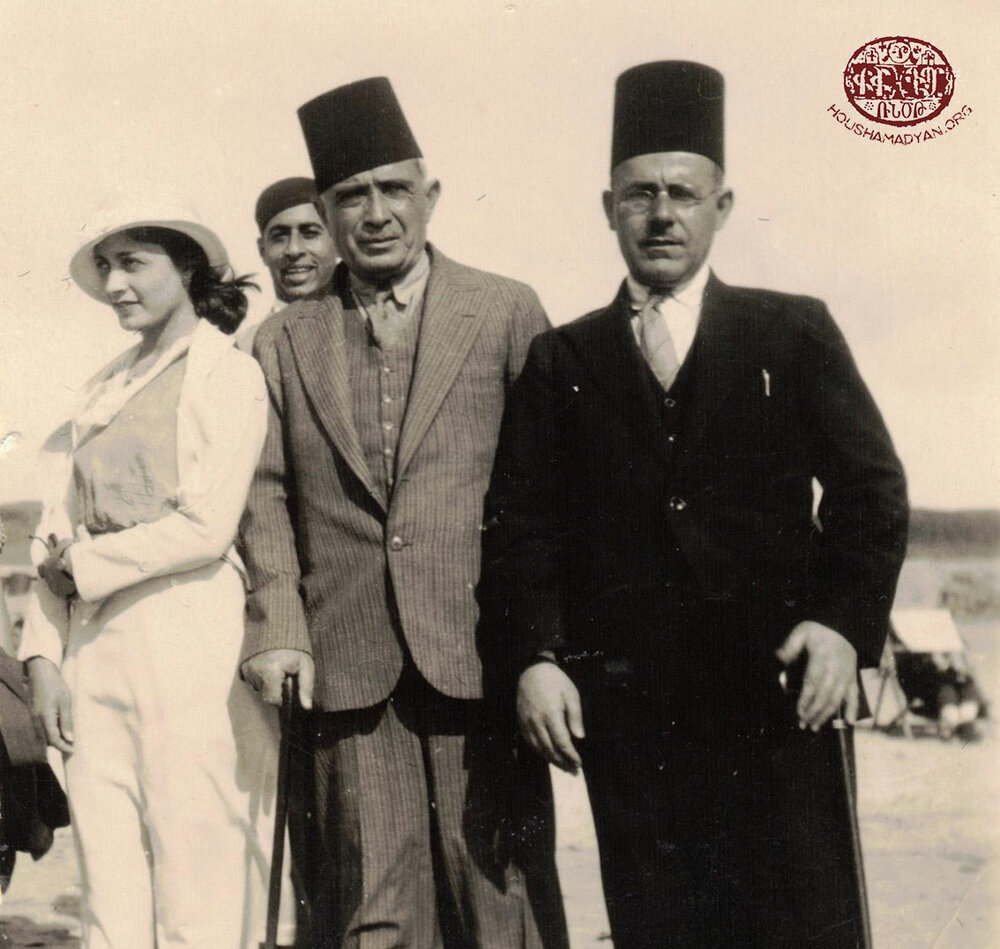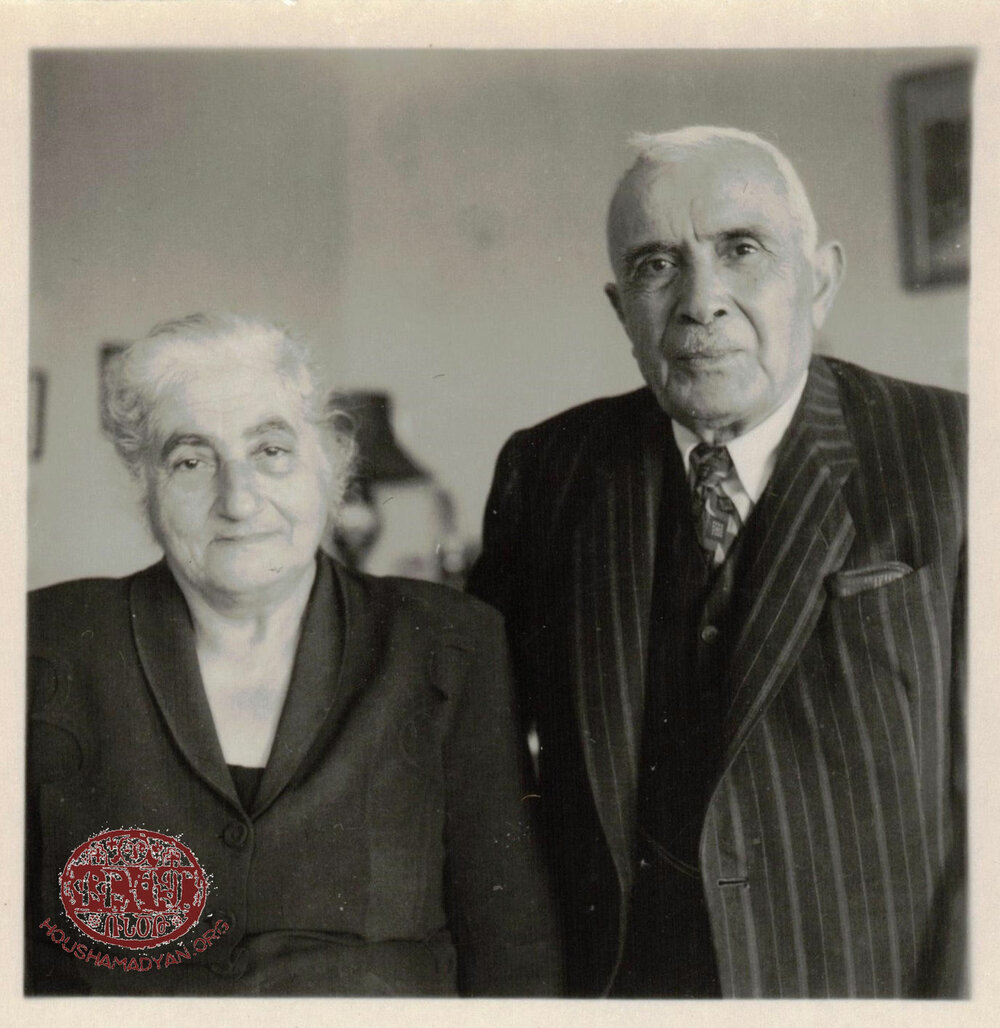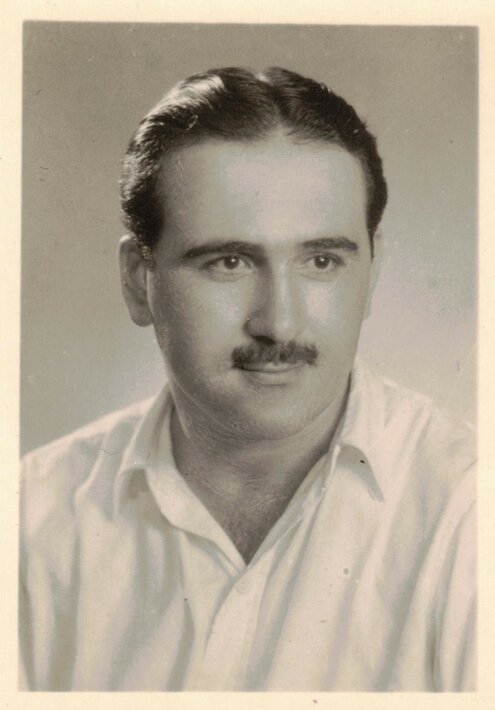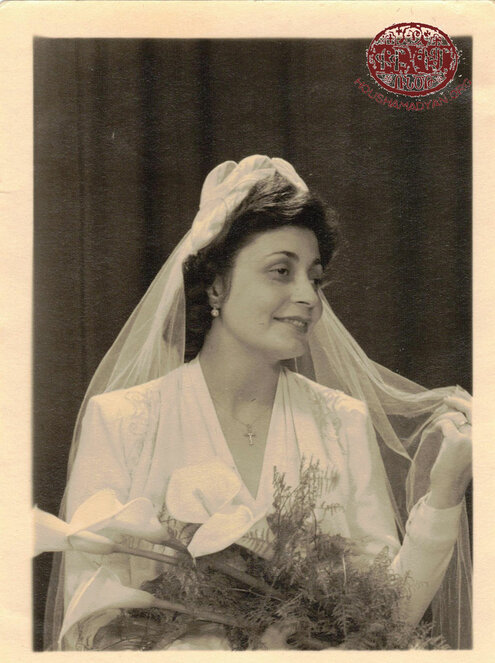Ashekian/Iynedjian/Bakalian/Bohdjelian Part V
POST IV: Bedros Parsegh Ashekian’s Descendants
Author: Anny Bakalian, New York, 21/03/2023 (Last modified 21/03/2023)

Parsegh Ashekian, the patriarch of the Uzun Ashekian Clan settled in Kayseri/Gesaria at the turn of the 19th century. Parsegh had two sons: Bedros and Garabed. Bedros had 11 children from two wives, while Garabed had six sons and one daughter. Bedros’s daughter, Mariam, married Hadji Haroutiun Iynedjian from Kayseri, and they had four daughters and three sons. These families intermarried within the Ashekian/Iynedjian Clan, and they kept in touch with each other.
Garabed P. Ashekian (from the Fourth Generation) left a book, Ուզուն Աշըգեան Գերդաստանին Պատմութիւնը [English: Garabed P. Ashekian, The History of Uzun Ashekian Clan, Beirut: Donikian Press, 1968. Translated into English by Vatche Ghazarian (Monterey, CA, 2013)].
Anny Bakalian and her sister, Ruby Gulian (descendants of Parsegh Garabed Ashekian and Diruhi Harutiun Iynedjian) have edited and updated the information about the relatives to the Fifth Generation: Those who went to Lebanon (Post I); Those who were in Constantinople/Istanbul (Post II); Those who went to Romania and eventually settled in USA and Canada via Beirut (PostIII). This last Post IV is about the other branch of the family: the descendants of Bedros Ashekian, the older son of Parsegh Ashekian. Garabed Ashekian’s book includes the family history and genealogy up to 1968. The editors have tried to locate the descendants of Bedros Ashekian and thank those who helped them update the family tree. Through Houshamadyan, they hope to find other “lost kin.”
During the Armenian Genocide, very few of the descendants of the Ashekian Clan died because of several reasons. First, Avedis Bohdjelian settled in Romania in 1896, and his relatives followed him. Second, Dikran Ashekian and his brother-in-law, Sarkis Bakalian, bought an electric flour mill in Adana in 1908; when the Ottoman Army confiscated the factory during World War I, those who were affiliated with the factory were exempt from deportation and death. Third, members of the Ashekian Clan used their connections in the government and their wealth to survive.
Early 1920s, some of the descendants of Garabed Parsegh Ashekian left Adana for Cyprus and then settled in Beirut. Some of the descendants of Bedros Ashekian who were deported during the genocide from their home, went back after the Armistice, but between May 1920 and October 1921, they all left Cilicia for good. They went to the Middle East (Beirut, Baghdad, Cairo, Alexandria, Haifa, and Tehran, among other places) and Argentina. At the turn of the 20th century, the Iynedjian families settled in Constantinople. After World War I, Nevrig (née Iynedjian), her husband, Taniel Allahverdian, and their son, Kevork, lived in Istanbul; his grandchildren still live there. Those who went to Romania lived comfortably until 1948, but when the country became Socialist Republic, life became miserable—they seized the properties, wealth, and jewelry. Almost all the descendants of the Ashekian Clan left Romania from 1951 to the mid-1960s because the American National Committee to Aid Homeless Armenians (ANCHA) had an office in Beirut and helped them to immigrate to the USA and Canada.

The Second Generation
Parsegh Uzun (Turkish for tall) Ashekian (First Generation) settled in Kayseri because of the persecution of the Persians in the late 1790s. He had two sons (Second Generation), Bedros P. Ashekian (born in Kayseri circa 1810—died in Kayseri circa 1890) and Garabed P. Ashekian (born in Kayseri in 1818—died in Adana in 1903). Father and sons were merchants and had caravans. Bedros had 11 offspring and Garabed had seven [See POST I], a total of 18 children that made a large clan.
Bedros Parsegh Uzun Ashekian was a merchant with his brother, Garabed. They transported merchandise on their caravans of camels to what is now Iraq and Iran. Often, they bought oxen and buffalos and rented them to the villagers around Kayseri during the harvest. They also went to Jerusalem and had the privilege to stay in the Armenian Quarter and follow the footsteps of Jesus. During the Ottoman empire, Armenians used the Arabic/Turkish name of the person who completed the pilgrimage to Jerusalem—Hadji. Pilgrims, including men, women, and children, tattooed a cross and the date of their visit on their arm as a remembrance of their visit.
Bedros was tall and very handsome in his youth. He married, but the name of his first wife was not known; they had two daughters and a son:
- Yeghisapet (née Bedros Parsegh Ashekian) Hadji Yeghia Taslakdjian (born in Kayseri circa 1845—died in Kayseri before 1915)
- Parsegh Bedros Parsegh Ashekian (born in Kayseri circa 1847—died in Kayseri)
- Mariam (née Bedros Parsegh Ashekian) Haroutiun Iynedjian (born in Kayseri circa 1850—died in Kayseri in 1872)
When his first wife died, Bedros remarried Mariam (née Merdinian) Ashekian. The family was prominent in Kayseri; they had eight children—three sons and five daughters:
- Anna (née Bedros Parsegh Ashekian) Garabed Aghajanian (born in Kayseri circa 1855— died in Der Zor circa 1915)
- Stepan Bedros Parsegh Ashekian (born in Kayseri circa 1857—died in Adana circa 1908)
- Nuritsa (née Bedros Parsegh Ashekian) Nazaret Tellalian (born in Kayseri circa 1859—died in Adana)
- Hovhannes Bedros Parsegh Ashekian (born in Kayseri circa 1861—died in Beirut circa 1922/Cilician Evacuation)
- Filor (née Bedros Parsegh Ashekian) Krikor Tekeyan (born in Kayseri circa 1864—died in Adana circa 1906)
- Sima (née Bedros Parsegh Ashekian) Haroutiun Ohanian (born in Kayseri circa 1865—died in Baghdad circa 1940)
- Shemsi (née Bedros Parsegh Ashekian) Bedros Tutunjian (born in Kayseri circa 1868—died in Armenia SSR after 1947)
- Shahmir Bedros Parsegh Ashekian (born in Kayseri circa 1870—died in Beirut in 1945)

The Third Generation (From the first wife of Bedros Ashekian)
1) Yeghisapet (née Bedros Parsegh Ashekian) (born in Kayseri circa 1845—died in Kayseri before 1915) married Hadji Yeghia Taslakdjian, a businessman. While most of the Ashekian Clan moved to Adana because there were more commercial opportunities there, Yeghisapet and Yeghia stayed in Kayseri until they died before the Genocide.
This couple had one son and two daughters:
- Movses Yeghia Taslakdjian (born in Kayseri circa 1875—died in Adana 1908)
- Ayguland Yeghia Taslakdjian (born in Kayseri circa 1879—died in Damascus)
- Gyuluzar Yeghia Taslakdjian (born in Kayseri circa 1882—died in Damascus)
Their son moved to Adana to work with his paternal uncle, Hadji Garabed Taslakdjian, who sold drapery to villagers. There, Movses had a shop for curtains. While he was learning to shoot in 1908, he died accidentally. The following year, his shop was pillaged during the Armenian Massacre. His parents were deeply traumatized by his premature death and the financial losses.
Yeghisapet’s and Yeghia’s daughters, Aygyuland and Gyuluzar, had learned how to weave rugs and earned their living that way. They were not married. They were deported during the Genocide and walked until the vicinities of Damascus.
2) Parsegh Bedros Parsegh Ashekian (born in Kayseri circa 1847—died in Kayseri) first worked with his father, Bedros P. Ashekian; then he had his own business. He married Takouhitsa; her family name was not known.
This couple had three sons and four daughters:
- Boghos Parsegh Ashekian (born in Kayseri circa 1877—died in Bursa)
- Haig Parsegh Ashekian (born in Kayseri in 1880 —died in Cairo circa 1947)
- Bedros Parsegh Ashekian (born Kayseri in 1882—died in Cairo)
- Ovsanna (née Parsegh Ashekian) Djivan Yeprimian (born in Kayseri circa 1885—died in Cairo)
- Haigazouhi (née Parsegh Ashekian) Hovhannes Oughourlian (born in Kayseri circa 1887—died in Cairo)
- Nouritsa (née Parsegh Ashekian) Hapet Nakashian (born in Kayseri circa 1890—died in Egypt)
- Satenig (née Parsegh Ashekian) Garabed Balian (born in Kayseri circa 1892—died in Holland circa 1966)
When Parsegh died, his wife, Takouhitsa, settled in Constantinople and died there.
3) Mariam (née Bedros Parsegh Ashekian) Haroutiun Iynedjian (born in Kayseri circa 1850— died in Kayseri in 1872) married Hadji Haroutiun Iynedjian (born in Kayseri circa 1825—died in Constantinople circa 1915) [see POST II]. While he was from the second generation, his wife was from the third generation. Hadji Haroutiun engaged in the business of silk threads and simultaneously occupied the position of the head of the quarter.
Haroutiun and Mariam had four daughters and three sons:
- Gyuldudu (née Iynedjian) Antreas Bohdjelian (born in Kayseri circa 1860—died in Bucharest in 1957) [see POST III].
- Dirouhi (née Iynedjian) Parsegh Ashekian (born in Kayseri, circa 1864—died in Beirut on June 11, 1968)
Her daughters, Haiguhi (née Ashekian) Bakalian and Marina (née Ashekian) Ashekian, went to Lebanon [see POST I]. Her sons, Garabed Ashekian (who wrote the book) and his brother, Hagop Ashekian, went to Romania [see Post III].
- Dikranouhi (née Iynedjian) Garabed Torosian (born in Kayseri died circa 1866—died in Istanbul on December 26, 1946) [see POST II].
- Nevrig (née Iynedjian) Taniel Allahverdian (born in Kayseri circa 1868–died in Istanbul in 1967)
Nevrig’s son Kevork Allahverdian, became Allahverdi in 1923 in Istanbul. He had a daughter, Sona, and two sons. Sona (née Allahverdi) married Pakrat Bakalian in Beirut; Anny Bakalian and Ruby (née Bakalian) Gulian are her daughters [see POST II].
- Hovhannes Haroutiun Iynedjian (born in Kayseri circa 1870—died in Romania circa 1940)
- Nazaret Haroutiun Iynedjian (born in Kayseri circa 1872—died during the Armenian Genocide close to Aleppo)
- Bedros Haroutiun Iynedjian (born in Kayseri in 1874—died in Lausanne in 1961) [see POST II].

The Third Generation (From the second wife of Bedros Ashekian)
4) Anna (Doudou) (née Bedros Parsegh Ashekian) Aghadjanian (born in Kayseri circa 1855—died in Der Zor circa 1915) married Garabed Aghadjanian(born in Kayseri circa 1845—died in Der Zor circa 1915), who was an educated man and a government employee of the Ottoman Empire.
This couple had two sons and two daughters:
- Krikor Garabed Aghadjanian (born in Kayseri circa 1875—died in Buenos Aires circa 1952)
- Bedros/Frère Pierre Garabed Aghadjanian (born in Kayseri circa 1877—died in Der Zor circa 1915)
- Dikranouhi (née Garabed Aghadjanian) Nevshehirlian (born in Kayseri circa 1880—died in Armenia SSR after 1947)
- Arshagouhi (née Garabed Aghadjanian) Antoun Svadjian (born in Kayseri circa 1883—died in Buenos Aires circa 1952)
Their eldest son, Krikor, had left the Ottoman Empire before the Armenian Genocide, during which his family was deported to Der Zor in the desert of Syria. The parents, Anna and Garabed, and Bedros, who became a Jesuit cleric, Frère Pierre, died. However, Krikor, Dikranouhi, and Arshaguhi survived.
5) Stepan Bedros Parsegh Ashekian (born in Kayseri circa 1857—died in Kayseri circa 1908) moved with his family to Adana. He practiced law as a profession. His grandmother, Mariam (née Merdinian) Bedros Ashekian, used to call him Ogul Bali (honey son). Stepan married Makrouhi (née Hadji Haroutiun Frenkian) (born in Kayseri—died in Nicosia).
Stepan and Makruhi had two daughters and a son:
- Gyulena Stepan Ashekian (born in Kayseri circa 1880—died in Cyprus in 1953)
- Azniv (née Stepan Ashekian) Hagop Bouldoukian (born in Kayseri circa 1882—died in Iskenderun in 1940)
- Bedros Stepan Ashekian (born in Kayseri in 1886—died in Beirut in 1958) married Marina Parsegh Ashekian [See POST I].
Stepan died before the Adana Massacre in 1909 and was buried in the Armenian cemetery in Adana within the Ashekian compound. Between 1921 and 1922, France evacuated Armenians from Cilicia (now in southern Turkey); among them was Stepan’s wife, Makrouhi, her daughter, Gyulena, and her son, Bedros, and his family. Makrouhi and Gyulena died in Cyprus. Bedros’s family resettled in Lebanon. The Bouldoukians first moved to Iskenderun, where their mother, Azniv, died; they then settled in Beirut.
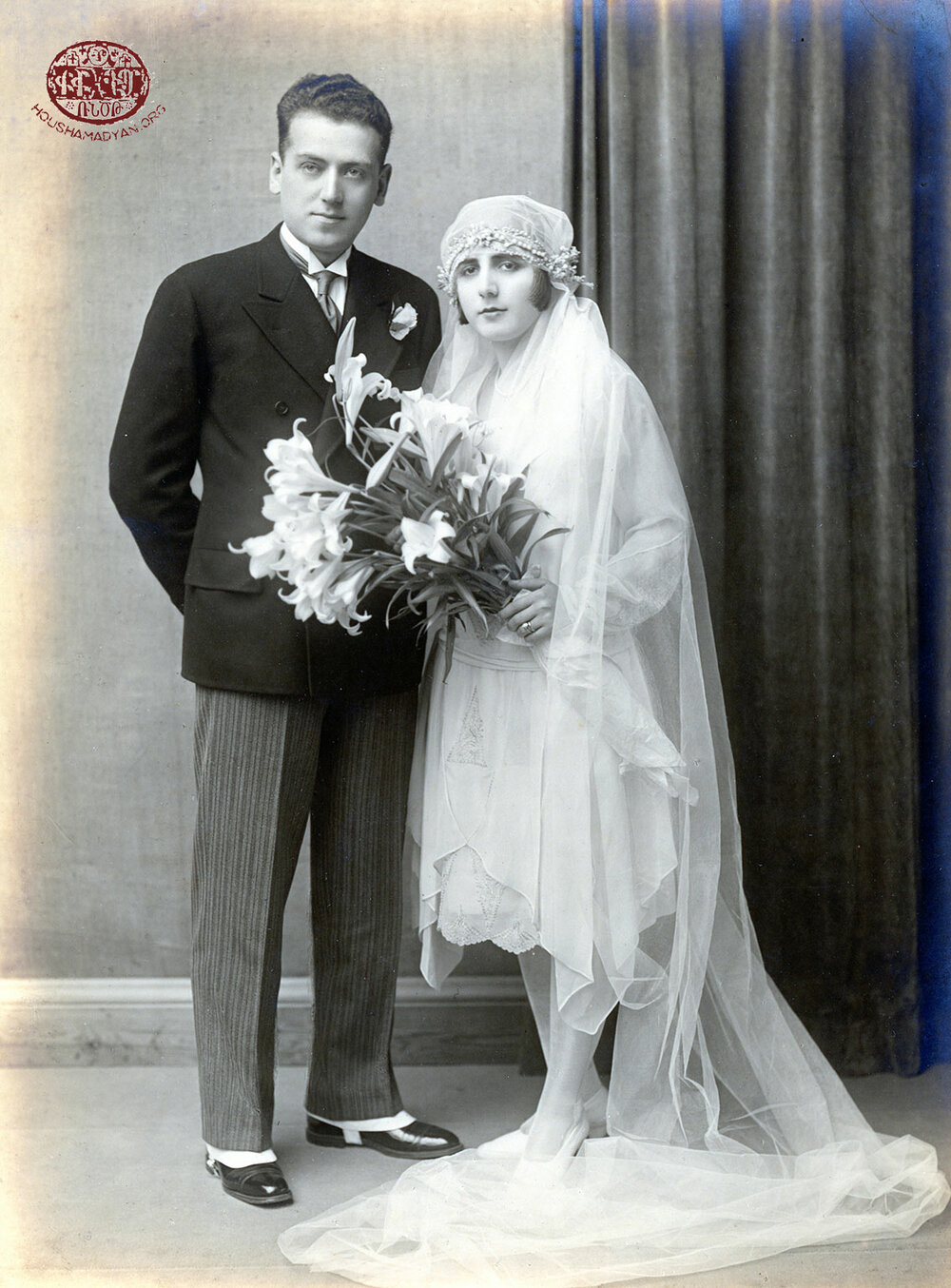
6) Nuritsa (née Bedros Parsegh Ashekian) Tellalian (born in Kayseri circa 1859—died in Adana) married Nazaret Tellalian (born in Kayseri circa 1839—died in Adana before WWI). Nazaret had a law practice in Adana, where the couple settled.
Nurista and Nazaret had two daughters and two sons:
- Takouhitsa(née Nazaret Tellalian) (born in Adana circa 1880-death not known) married Iknadios Oughourlian (born in Kayseri). They did not have children.
- Azniv (née Nazaret Tellalian) Nazaret Kevork Tekeyan (born in Adana circa 1882—died in Egypt)
- Onnig Nazaret Tellalian (born in Adana circa 1885 –died in Beirut circa 1935)
- Mazhag Nazaret Tellalian (born in Adana circa 1887—died in Alexandria circa 1940)
7) Hovhannes Bedros Parsegh Ashekian (born in Kayseri circa 1861—died in Beirut after Cilician Evacuation circa 1922) moved to Adana following many of his relatives. Hovhannes opened a store; his clients were prominent Turks and officers. He married Takouhi (née Jebrayel Varjabedian) Hovhannes Ashekian (born in Kayseri—died in Iran). After the 1909 Massacre in Adana, the couple lived in Mersin, and Hovhannes purchased the Alegeozian fabric store; it was a lucrative business.
Hovhannes and Takouhi had two sons and a daughter:
- The first son (born in Kayseri circa 1890) was born with a bump on his head. During his christening in Mersin, the boy slipped from the hands of the godfather and fell. The child’s bump exploded, and he died.
- The second son (born in Kayseri circa 1895) was handsome. When he was three or four years old, while playing by the window of their house, he fell on the street and died. Alas, this accident created bickering between his parents.
- Arous/Arousyag (née Hovhannes Ashekian) Puzant Kalaydjian (born in Mersin circa 1905—died in Florida, USA circa 1995)
Hovhannes closed his shop during the deportation in 1915 and placed his merchandise in safekeeping in a bank. His family was exiled to Aleppo. There he found Ali Munif, the Governor of Mount Lebanon, who was an acquaintance from Adana. Munif issued orders for his family’s transfer to Lebanon; they stayed there until the Armistice.
Hovhannes returned to Mersin to sell his merchandise, but the safe in the bank was empty. He turned to Bedros, his sister, Mariam’s, son who was smart and trustful. Bedros was about two years old when his mother died and his father, Haroutiun Iynedjian, raised him and sent him to Kastemoni/Kastamonou to learn trading. Bedros became a good businessman in Constantinople and later in Switzerland. Bedros gave his uncle a credit and Hovhannes eventually fulfilled his debt.
During the Cilician Evacuation, Hovhannes moved his family to Beirut. His wife, Takouhi, daughter, Arousyag, and Takouhi’s brother, Hagop Varjabedian, moved to Iran. Arousyag got married in Iran in 1929.
8) Filor (née Bedros Parsegh Ashekian) Krikor Tekeyan (born in Kayseri circa 1864—died in Adana circa 1906) married Krikor Mourad Tekeyan (born in Kayseri—died in Adana 1909). Krikor was the brother of Hripsimé Garabed Ashekian [see POST I]. When Krikor married Filor, he was a widower, and he had a son, Nazaret.
Filor and Krikor Tekeyan had four daughters and a son:
- Marie (née Krikor Tekeyan) Krikor Kalbadjian (born in Adana circa 1882—died in Buenos Aires circa 1950s)
- Hapet Krikor Tekeyan (born Adana circa 1884—death is not known)
- Zori (née Krikor Tekeyan) Mesia Pamboukian (born in Adana circa 1886—death not known)
- Azniv (née Krikor Tekeyan) Peniamin Telalian (born in Adana circa 1889—death not known)
- Naomi (née Krikor Tekeyan) Krikor Abadjian (born in Adana circa 1892—died in Los Angeles in May 1983)
On a cloudy night bursting with thunder and lightning, relatives had come to Filor’s house for a celebration. At some point, as Filor left the room to go to the kitchen, a thunderbolt struck the well in the middle of their court, and she fell dead on the ground in front of the kitchen door. Her husband, Krikor, died during the Adana Massacre.
9) Sima (née Bedros Parsegh Ashekian) Ohanian(born in Kayseri circa 1865—died in Baghdad circa 1940) married Haroutiun Ohanian, a businessman (born in Kayseri circa 1845—died circa 1913 in Adana).
The couple owned a house in Djamus Gyolou quarter of Adana and a 300 acres orchard in Kurd Tepe. Haroutiun Ohanian contracted with the Mersin-Tarsus-Adana Railway (MTA) to transport goods to Adana. He paid for the construction of a large warehouse attached to the rail station. He also hired horses/mules, handlers, and supervisors. He was a successful businessman.
Sima and Haroutiun had three sons and two daughters:
- Hagop Haroutiun Ohanian (born in Adana circa 1881—died in Baghdad in 1923)
- Azniv (née Haroutiun Ohanian) Salim Damlamian (born in Adana circa 1882—died in Adana in 1919)
- Hovhannes Haroutiun Ohanian (born in Adana circa 1884—died in Adana’s Massacre in 1909)
- Vahé Haroutiun Ohanian (born in Kayseri circa 1886—died in Basra in 1966)
- Victoria (née Haroutiun Ohanian) Nishan Yalenezian (born in Kayseri circa 1887—died in Yafa/Jaffa in 1963)
Haroutiun died in Adana before World War I. Sima moved to Baghdad circa 1922 when their son, Hagop, settled there. Hagop also brought his brothers, nephews, and nieces to Baghdad, but he unfortunately died three months later in 1923.
10) Shemsi (née Bedros Parsegh Ashekian) Tutundjian(born in Kayseri circa 1868—died in Armenia SSR after 1947) married Bedros Tutundjian (born in Kayseri—died in Adana before 1915). He worked in the local government of Adana and owned an orchard across from Stone Bridge/Taşköprü and the Seyhan (Sarus) River.
Shemsi and Bedros had two sons and a daughter:
- Aram Bedros Tutundjian (born in Adana circa 1880—died in Beirut circa 1944)
- Puzant Bedros Tutundjian (born in Adana circa 1885—died in Armenia SSR)
- Lousadzin (née Bedros Tutundjian) Karekin Samourkashian (born in Adana circa 1890—died in Beirut circa 1960)
During World War I, Aram and Puzant Tutundjian found jobs in the floormill of Dikran Ashekian and Sarkis Bakalian and were not conscripted nor deported. During the Cilician Evacuation, Shemsi went to Beirut with her family. When the Soviets called Armenians in the Diaspora to “repatriate” to Armenia SSR (1946-1948), Shemsi went with her sons, their wives, and the grandchildren. However, Lousadzin stayed with her family in Beirut.
11) Shahmir Bedros Parsegh Ashekian (born in Kayseri circa 1870—died in Beirut in 1945) followed his siblings to Adana and partnered with Aharon Patapanian to deal with buying/selling salt in Duz Khane/Cilicia. He took government contracts and received commissions. Shahmir also had a farm near Kardash.
Shahmir Bedros Ashekian married Aygoul (died in Beirut circa 1940s), whose father’s name was Sarkis, but the family name was not known. Sarkis was a farmer from Gyavur village by the Seyhan River.
Shahmir and Aygoul had one son:
- Karekin Shahmir Ashekian (born in Adana circa 1890—died in Beirut circa 1958)
During the Genocide, the family was deported to Daraa, a town in southwest Syria close to the border of Jordan. They worked in a farm to earn their food. After the Armistice in 1918, they returned to Adana. However, their sojourn was very short. In 1921, the Treaty of Ankara that ended the Franco-Turkish War led to evacuating the Armenians from their lands, properties, and lives. Shahmir and his family went to Beirut; there, he traded wood and coal for the locals.

The Fourth Generation
1) Descendants of Yeghisapet (née Bedros Ashekian) Taslakjian
They had a son and two daughters:
Movses Yeghia Taslakdjian(born in Kayseri circa 1875—died in Adana 1908) the son of Yeghisapet (née Bedros Ashekian) and Yeghia Taslakjian of Kayseri, settled in Adana to work with his paternal uncle, Hadji Garabed Taslakjian. His uncle would buy drapery and take them on horses to sell them in villages. And he would travel to Beirut to replenish his merchandise. Uncle Garabed helped Movses open a shop for curtains in Adana. In 1908, he died by accident while he was learning to shoot a pistol. The next year during the Armenian Massacre in Adana, his shop was plundered. Movses’s parents were deeply traumatized by his premature death and the financial losses.
Yeghia Taslakdjian’s brother, Hadji Garabed Taslakdjian, married before the Armistice (1918) and had a daughter. During the Cilician Evacuation, his family moved to Lebanon. After his death in Beirut, his wife and daughter settled in France.
Yeghisapet and Yeghia Taslakdjian’s two daughters, Aygouland Yeghia Taslakdjian(born in Kayseri circa 1879—died in Damascus) and Gyuluzar Yeghia Taslakdjian (born in Kayseri circa 1882—died in Damascus) were not married. They had learned to weave rugs and made a living by selling them. During the Genocide, they were deported on foot and ended up in the vicinities of Damascus. In 1918, the Armistice allowed the sisters to return to Adana as survivors. Their relatives gave them a house in the Ashekian farm, allotted in Eski Seray.
After three years in Adana, Ayguland and Gyuluzar were exiled from Cilicia because the French abandoned the Armenians in 1921. They settled in Damascus and continued to earn their living by weaving and selling rugs. They died in the capital of Syria and were buried in the Armenian cemetery in Damascus.
2) Descendants of Parsegh Bedros Parsegh Ashekian and Takouhitsa
They had three sons and four daughters:
Boghos Parsegh Ashekian (born in Kayseri circa 1877—died in Bursa circa 1910) went to Smyrna to find employment, where he was accused of being a revolutionary and sentenced to death. Only converting to Islam would keep him from the gallows. He was smart and changed his name to Kamil. Once Islamized, he joined the police, and within few years, he was the Commissioner of Beşiktaş (Constantinople). He had also married a Turkish wife.
In 1905-1906, his relatives, Dirouhi (née Iynedjian) Parsegh Ashekian [see POST I], her father, Hadji Haroutiun Iynedjian, and her four children were going to see Hovhannes and Nazaret Haroutiun Iynedjian in Kastemoni. Their ship sailed from Mersin and was to drop them in Samsun on the Black Sea; however, the trip was more arduous because the Armenian Revolutionary Federation had tried to kill Sultan Abdul Hamid II (the Yildiz assassination attempt, July 21, 1905). When they arrived in Constantinople, they sent a message to Bedros Haroutiun Iynedjian to get the aid of their relative, Kamil (aka Boghos Parsegh Bedros Ashekian). He resolved the issue first by obtaining permission to get the travelers off the boat, and then he bought them train tickets from Haydar Pasha Terminal to Ankara. The travelers arrived in Kastemoni by cart.
After the Young Turk Revolution (1908), Kamil/Boghos’ wife had bought a house for them in Bursa. Before joining his wife, he went to Cilicia to visit his relatives, and he enjoyed his sojourn, quenching his longing. He died few years later in Bursa.
Haig Parsegh Ashekian (born in Kayseri circa 1880—died in Cairo circa 1920) went to Kastemoni to work with his brother, Bedros. They opened a retail store in a town called Taşköprü, not far from the city. Their sister, Nourista (née Parsegh Ashekian) (born in Kayseri circa 1890—died in Egypt), was married to Hapet Nakashian (born in Kayseri circa 1890—died in Egypt), a local businessman.
Upon correspondence with their youngest sister, Satenig, who was betrothed in Egypt, they decided to move to Cairo by way of Adana. Since Dirouhi P. Ashekian, the daughter of their paternal aunt, and her family were visiting her brothers in Kastemoni, the two brothers joined them on their way back and came to Adana.
Despite Sultan Abdul Hamid’s laws at the time, their paternal uncle, Hovhannes Ashekian, managed to obtain travel documents for them under the pretext that they would purchase goods for his store from Beirut. They embarked on a boat in Mersin and landed directly in Port Said and settled in Cairo.
Haig worked as a jeweler in Egypt and died after World War II. He was buried in the Armenian cemetery of Cairo. He was a bachelor.
Bedros Parsegh Ashekian(born in Kayseri circus 1882—died in Cairo) went to Kastemoni to work with his brother, Haig. They opened a retail store in a town called Taşköprü, not far from the city.
Their sister, Nouritsa (née Parsegh Ashekian) (born in Kayseri circa 1890—died in Egypt), was married to Hapet Nakashian (born in Kayseri circa 1890—died in Egypt), a local businessman.
In about 1910, Bedros married Hapet’s sister, Parantsem(née Mihran Nakashian) Ashekian (born in Kastemoni in May 1912—died in Toronto in 1989).
Bedros and Haig, with the help of their uncle Hovhannes Ashekian, obtained two travel papers supposedly to go to Beirut to buy merchandise for their store. The brothers eventually settled in Egypt, which was de facto not part of the Ottoman Empire.
Bedros and Parantsem had a daughter and a son:
- Alice-Takouhi (née Bedros Ashekian) Aram Alexanian (born in Cairo in 1930—died in Ottawa, Canada in 1976)
- Parsegh Bedros Ashekian (born in Cairo in 1931- died in Ottawa, Canada on May 25, 2022)
Ovsanna (née Parsegh Ashekian) Djivan Yeprimian (born in Kayseri circa 1885—died in Cairo) married Djivan Yepremian (born in Kayseri) and settled in Constantinople. She did not have children, but Jivan had a daughter from his first wife. The daughter was betrothed to Dr. Roteosian, well known in Constantinople. After World War I, Ovsanna joined her brother, Bedros, in Cairo, Egypt, where she died.
Nouritsa (née Parsegh Ashekian) Hapet Nakashian (born in Kayseri circa 1890—died in Egypt) married a businessman, Hapet Nakashian in Kastamonu, whose roots were from Kayseri circa 1910.
They had two daughters and a son:
- Veronica (née Hapet Nakashian) Stepan Giragosian (born in Kastemoni circa 1911—died in Cairo)
- Haroutiun Hapet Nakashian (born in Kastemoni circa 1912—died in Cairo) married Arshalouys, an orphan from the Genocide.
- Vertayim (née Hapet Nakashian) Garbis Paklayan (born in Kastemoni circa 1914—died in Beirut circus 1995)
Nouritsa and Hapet Nakashian settled in Egypt after World War I following her brothers.
Haigazouhi (née Parsegh Ashekian) Hovhannes Oughourlian (born in Kayseri circa 1887—died in Cairo) married Hovhannes Oughourlian, a businessman.
During the Genocide, the entire family was deported; all died except one daughter, Manoushag. She was found in Meskeneh (southeast of Aleppo/west of Raqqah). Dikran Ashekian and his family were in Aleppo during the War, so Manoushag was delivered to Dikran. During the Armistice, when Dikran’s family returned to Adana, they brought Manoushag Oughourlian with them.
With the end of the Franco-Turkish War in 1921, the Armenians had to evacuate from Cilicia. The Clan helped Manoushag Oughourlian travel to Cairo, and her maternal aunt, Satenig Balian, welcomed her to live with her in Cairo.
Satenig (née Parsegh Ashekian) Balian (born in Kayseri in 1886—died in Holland in 1964) married Garabed Balian(born in Kayseri 1867—died in Cairo in 1942). Garabed was from Kayseri and had settled in Cairo. He was in the (gold and other precious metals) bullion business, a talented artisan, and a respected man. Before Satenig moved to Egypt in 1904, she visited her relatives in Adana.
Satenig and Garabed had two sons and a daughter:
- Assadour Garabed Balian (born and died in Cairo 1906—1989)
- Marie (née Garabed Balian) (born and died in Cairo 1909—in the 1980’s)
- Parsegh Garabed Balian (born in Cairo circa 1913—died in Holland in 1981)
Satenig died while visiting her son, Parsegh, and family in Holland in 1964.
3) Descendants of Mariam and Haroutiun Iynedjian
[See PHOST I, II, III]
4) Descendants of Anna (Doudou) and Garabed Aghadjanian
They had two sons and two daughters:
In 1915, this family was deported to Der Zor in the desert of Syria. The parents, Anna and Garabed, and Bedros who became a Jesuit cleric, Frère Pierre, died. However, Krikor and his sisters, Dikranouhi and Arshagouhi Aghadjanian, survived.
Krikor Garabed Aghadjanian (born in Kayseri circa 1875—died in Buenos Aires in 1952) married a woman from Kayseri; they did not have children. Krikor briefly worked at the rail company in Adana and then went to Paris.
In his book, Garabed Ashekian mentions that he met Krikor Aghadjanian in Alexandria in 1911; he had remarried and had two sons. Then, Krikor took his family to Buenos Aires.
In the 1960s, while Garabed Ashekian was corresponding with the Ashekian Clan from Kayseri for his book, Hapet Kalbdjian confirmed in a letter that Krikor Aghadjanian had settled in Argentina.
Bedros/Frère Pierre Garabed Aghadjanian (born in Kayseri circa 1877—died in Der Zor circa 1915) received his education at the Jesuit School of Kayseri, converted to Catholicism, and became a teacher at their school in Adana. Later, he studied at a seminary in London and became a Jesuit priest; they called him Frère Pierre.
During the Genocide, Frère Pierre and his parents were deported to Syria and died in Der Zor.
Dikranouhi (née Garabed Aghadjanian) Nevshehirlian (born in Kayseri circa 1880—died in Armenia SSR) married Hadji Nevshehirlian. They had a daughter (born in Adana circa 1900—died in Armenia SSR), her name was not known.
After the evacuation of Cilicia 1921, the Nevshehirlian family settled in Syria or Lebanon. After World War II, the Soviets encouraged Armenians to repatriate to Armenia SSR, and this family settled in Yerevan circa 1947.
Arshagouhi (née Garabed Aghadjanian) Svadjian(born in Kayseri circa 1883—died in Buenos Aires in 1952) married Antoun Svadjian (born Constantinople—died in Buenos Aires in 1930). Her brother, Frère Pierre, introduced Arshagouhi to her husband, whose business was making heaters. The couple settled in the capital of the Ottoman Empire, then in 1923, along with their offspring moved to Buenos Aire.
Arshagouhi and Antoun had three daughters and a son:
- Zabel (née Antun Svadjian) (born Constantinople circa 1905—died in Istanbul). Her husband’s name was not known nor if they had children.
- Filor (née Antoun Svadjian) Hapet Kalbdjian (born Constantinople circa 1907—died in Buenos Aires). Filor was named after her grandmother, who had died in her kitchen from a lightening explosion circa 1906.
- A son (first name unknown) Kalbdjian (possibly born in Argentina circa 1927) had a car mechanic shop in Buenos Aires, married a local woman, and they had two daughters: one was married to an Italian, and there is no data on the younger daughter.
- Youngest daughter (name unknown) (died in Buenos Aires in 1963)
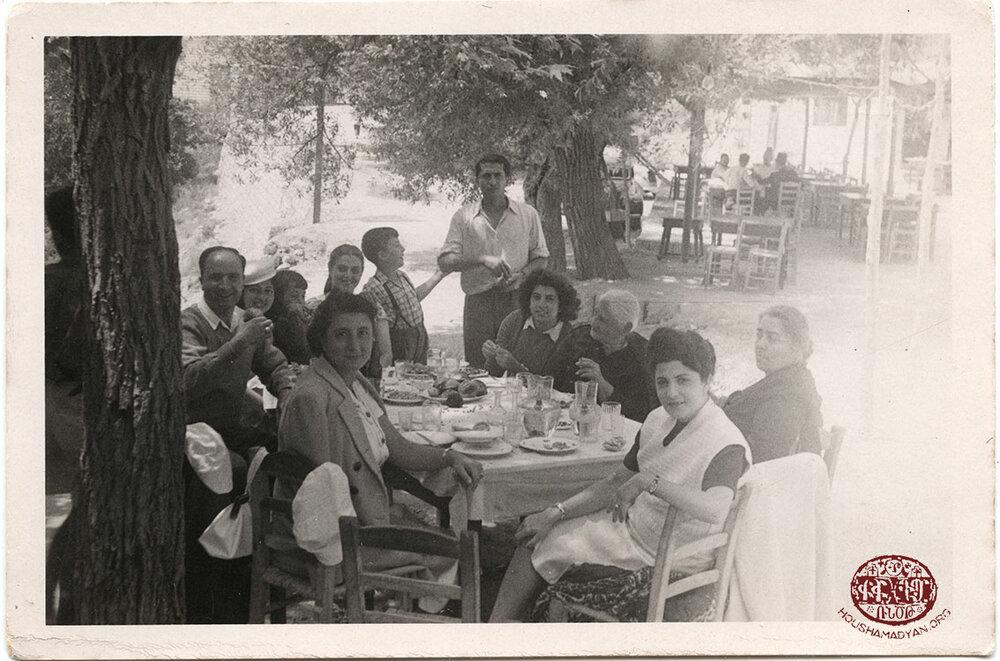
5) Descendants of Stepan Bedros Ashekian
They had two daughters and a son:
Gyulenia Stepan Bedros Ashekian(born in Kayseri circa 1880—died in Cyprus in 1953) she had a malady as a child; one of her arms was weak and disabled. Gyulenia was not married; during the evacuation of Cilicia, her brother, Bedros, took her with his family to Cyprus. When Bedros, his wife, Marina, and their two girls relocated to Beirut, he sent her monthly funds to live until she died.
Azniv (née Stepan Bedros Ashekian) Hagop Bouldoukian’s(born in Kayseri circa 1882—died in Iskenderun in 1940) family moved to Adana, where she received her education at the Armenian school of Adana and the American School for girls. Azniv married Hagop Bouldoukian circa 1900 (born in Adana—died in Beirut in 1945). Hagop was a merchant of sheep and cows; when his father died, the business was passed on to him.
They had three daughters and two sons:
- Arousyag (née Hagop Bouldoukian) Antranig Keshishian (born in Adana circa 1901—died in Beirut)
- Araxi (née Hagop Bouldoukian) Haig Geotsekdjian (born in Adana circa 1903—died in Beirut)
- Alice (née Hagop Bouldoukian) Garbis Degirmenjian (born in Adana circa 1904—died in Beirut)
- Samuel Hagop Bouldoukian (born in Adana circa 1906—died in Beirut)
- Vahé Hagop Bouldoukian (born in Adana circa 1908—died in Beirut in 1975)
During the Adana Massacre of 1909, several Turkish men left from Boklu Khan (Shit Khan) and went into Hagop Agha Bouldoukian’s butcher shop that was located close to the inn. There they started to plunder and loot the shop. Hagop Bouldoukian’s brothers, Haroutiun and Garabed, and one of their relatives, Khacho, started combating with Turks. Later, the court accused the Armenians of killing the Turks, without any evidence. The court martial hung Haroutiun, Garabed, and Khacho as criminals.
Hagop Agha Bouldoukian was lucky because he was in Syria to purchase sheep during the massacre in 1909. However, in 1915, his family joined the deportation caravans to the Syrian Desert, probably stayed in one of the villages along the Euphrates.
After the Armistice in 1918, the Bouldoukians returned to Adana and Hagop resumed his business, but when the French abandoned Cilicia (1921), the Bouldoukian family relocated to Iskenderun. In 1939, the Sandjak of Alexandretta became the Hatay State of the Republic of Turkey; most of the Armenians and Christian Arabs left.
Azniv and Hagop Bouldoukian’s eldest daughter, Arousyag, married Antranig Keshishian before the Cilician Evacuation in 1921.After the death of Azniv (née Stepan Ashekian) Bouldoukian in Iskenderun, her husband took his family, including his son-in-law, Antranig Keshishian, to Lebanon. Hagop Bouldoukian continued his business in Beirut until 1945 when he died.
Bedros Stepan Bedros Ashekian (born in Kayseri in 1886—died in Beirut in 1958)
In 1917, Bedros married Marina Parsegh Ashekian in Mersine; she was 21 years old, and he was 31 years old. As most of the marriages of this clan, they were related. Bedros’s grandfather was Bedros Parsegh Ashekian, son of the patriarch of the clan and Marina's grandfather was his brother Garabed Parsegh Ashekian [See Post I].
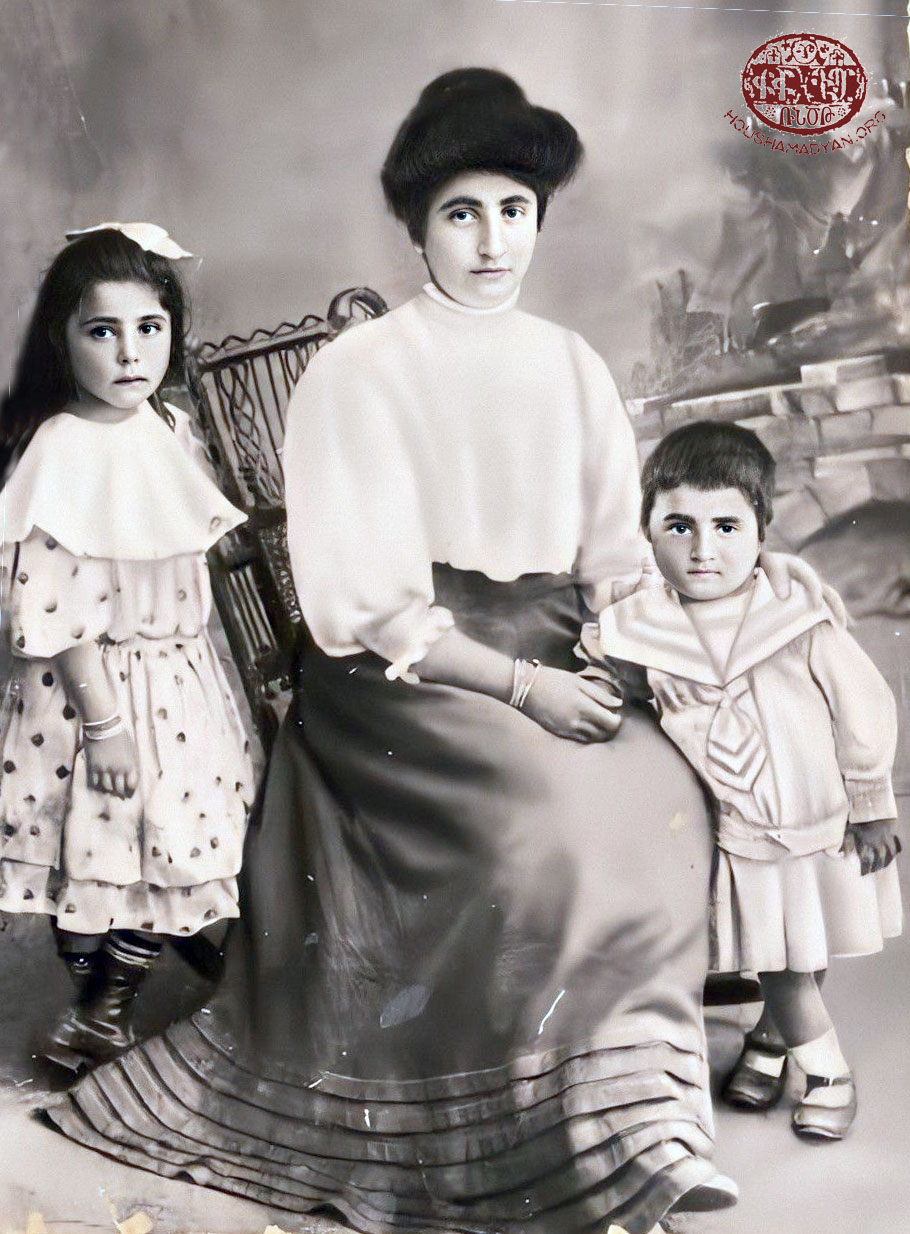
6) Descendants of Nouritsa and Nazaret Tellalian
They had two daughters and two sons:
Takouhitsa (née Nazaret Tellalian)(born in Adana circa 1880—death not known) married Iknadios Oughourlian (from Kayseri). They did not have any children.
Azniv (née Nazaret Tellalian) (born in Adana circa 1882—died in Egypt circa 1940) married Nazaret Kevork Tekeyan (born in Adana—died before the Armistice). Nazaret was a baby when his mother died; his father remarried with Filor (née Bedros Ashekian), and she treated Nazaret as her son. Nazaret’s business was fabrics.
Nazaret and Azniv had a son and a daughter:
- Garbis Nazaret Tekeyan (born in Adana circa 1908—died in Alexandria, Egypt)
- Daughter (name unknown)
During World War I, Azniv stayed in Adana. After the Armistice in 1918, France occupied Cilicia and allowed the Armenians who survived to resettle Adana. However, this period was short; the evacuation of Cilicia forced her to leave her home and city. First, Azniv and her son, Garbis, moved to Cyprus, then went to Alexandria, Egypt because her brother, Majag Tellalian, lived there.
Onnig Nazaret Tellalian (born in Adana circa 1885 –died in Beirut circa 1935) was a graduate of the Sanasarian School of Garin/Erzurum and was in the insurance business and solicitations. He was not married. During the evacuation of Cilicia, he settled in Beirut and died there.
Majag Nazaret Tellalian (born in Adana circa 1887—died in Alexandria circa 1950) settled early in Alexandria. He married a Greek woman; they had one son:
- Onnig Majag Tellalian
In the 1960s, when Garabed Ashekian corresponded with the Ashekian Clan, Onnig Majag Tellalian was living in Alexandria making shirts and hats in his shop.
7) Descendants of Hovhannes Bedros Parsegh Ashekian
They had a daughter:
Arousyag (née Hovhannes Ashekian) (born in Adana circa 1905—died in Florida circa 1995) received her education in Cilicia and then in Iran.
In 1929, Arousyag married Puzant Kalaydjian (birth not known—died in Florida circa 1990s) Their wedding photo was taken in London. Puzant was the son of Kevork and Tenfu from Iran. Father and son bought and sold oriental carpets.
Arousyag and Puzant had two sons and two daughters:
- Yetvart Puzant Kalaydjian (born in Iran in 1931)
- Sirvart Puzant Kalaydjian (born in Iran in 1932)
- Aram Puzant Kalaydjian (born in Iran in 1936)
- Marguriet Lindsey Puzant Kalaydjian (born in New York in 1947)
In 1940, the Kalaydjian family moved to the United States, and Puzant continued his contacts in Iran because his merchandise was from there. They purchased a house in Great Neck, NY, and Puzant commuted to Manhattan daily.
Americans found the name Arousyag difficult, so she told them to call her Kay. When her children grew up and left their home, she started to work in a department store close to her house.
Puzant and Arousyag retired in Ormond Beach in Florida in USA; they both died in their 90s.
8) Descendants of Filor (née Bedros Ashekian) Krikor Tekeyan
They had four daughters and one son:
Marie (née Krikor Tekeyan) Krikor Kalbdjian(born in Adana circa 1882—died in Buenos Aires circa 1950s) married Krikor Kalbdjian (born in Adana—died Adana in 1909) before her mother’s death in 1906 and had children. Krikor died during the Adana Massacre.
After the Genocide, Marie and her children were deported to the desert. In his book, Garabed Ashekian mentions they had two sons; we do not know if they were born before or after World War I. We know that during this long journey, Marie met Mr. Meletdjian, and they married when they returned to Adana during the Armistice in 1918.
Marie and her husband went to Buenos Aires in the 1930s. About 60 percent of the Armenian immigration to Argentina was from Cilicia.
In his book, Garabed Ashekian says that Marie’s son, Bedros, was a mechanic in Buenos Aires.
Bedros Meletdjian had three daughters; names unknown:
- First daughter (born in Buenos Aires circa 1945) was a hairdresser around 1968.
- Second and third daughters (born circa 1950) not known.
Hapet Krikor Tekeyan (born in Adana circa 1884—death not known) was a shoemaker. Hapet married Zabel Svadjian.
Hapet and Zabel had two sons: one was a dentist and the younger brother was his assistant.
Zori (née Krikor Tekeyan) Mesia Pambukdjian (born in Adana circa 1886—death not known)
Azniv (née Krikor Tekeyan) (born in Adana circa 1889—died in Athens) marriedAgha Peniamin Telalian (born in Adana–died in Athens). Peniamin traded animals’ intestines. During the Armenian Genocide, he was spared from deportation as he had a job at the Ashekian Mill. Most of the men in the Ashekian Clan avoided deportation because they found employment at the Ashekian-Bakalian flourmill in Adana [see POST I].
Azniv and Peniamin had two daughters and two sons:
- Filomin Peniamin Telalian (born in Adana circa 1914)
- Arpiné Peniamin Telalian (born in Adana circa 1916)
- Haroutiun Peniamin Telalian (born in Adana circa 1918) who continued his father’s business of trading animal intestines.
- Hmayag Peniamin Telalian (born in Adana circa 1920) was a shoemaker in Athens.
During the evacuation of Cilicia, the Telalian family first went to Cyprus, then settled in Greece. Peniamin continued his business of trading animal intestines in Athens, and by 1960s, he had built a private building in Athens. Their offspring were not married.
Naomi (née Krikor Tekeyan) (born in Adana circa 1886—died in Los Angeles in May 1983) married Krikor Abadjian (born in Adana—died in Los Angeles circa 1960s), who was a teacher. After the Adana Massacre in 1909, he worked in a French company. During World War I, the Abadjian family was deported, and two daughters and a son died on the journey. They returned to Adana, but in 1921, the Armenians evacuated Cilicia. This family went to Smyrna/Izmir and immigrated to Greece at the end of 1922.
In Athens, Krikor resumed his teaching and then decided to become a priest (kahana in Armenian) because the Armenian Apostolic Church allows both celibate and married priests. When Krikor finished his seminary studies, he took the name Tateos/Thaddeus. A parish in Los Angeles needed a priest, so Father Tateos Abadjian settled in Los Angeles circa 1950.
Naomi and Krikor had two sons and a daughter:
- Sarkis Krikor Abadjian (born in Adana in 1922—died in California) married Katina Dalketis, whose roots were Greek. Their wedding was in Los Angeles in February 1953.
Sarkis and Katina had a son and a daughter:- Krikor-Mark Abadjian (born in Los Angeles in 1955)
- Erika Abadjian (born in Los Angeles in 1960)
Sarkis owned a restaurant and lived in Monterey Park.
- Zaven Krikor Abadjian (born probably in Greece circa 1927—died in California) married Kohar Aghadjanian, whose parents were Margos and Kristiné from Eastern Armenia. Their wedding was in Los Angeles in July 1956.
Zaven and Kohar had two sons and a daughter:- Mark-Zaven Abadjian (born in Los Angeles in 1964)
- John-Bedros Abadjian (born in Los Angeles in 1961)
- Naomi Abadjian (born in Los Angeles in 1964)
Zaven worked with his brother after a car accident. Grandmother Naomi lived with Zaven until her death.
- Naomi Krikor Abadjian (born in Greece circa 1930—death not known) married Misag Hagopian, who was from Adana. They had two daughters and a son:
- Victor Hagopian (born in Athens)
- Madeleine Hagopian (born in Athens)
- Hagop Hagopian (born in Athens)
All the three offspring married Greeks.
9) Descendants of Sima and Haroutiun Ohanian
They had three sons and two daughters:
Hagop Haroutiun Ohanian (born in Adana circa 1881—died in Baghdad in 1923) graduated from the Berberian College of Uskudar in Constantinople and worked with his father for a while. He was engaged to the sister of Vahan Malezian (1871-1966, poet, writer, translator, political activist), but unfortunately, his fiancée died.
The authorities accused Hagop Ohanian of revolutionary activities. He escaped from Mersin to Cyprus by hiding in a large alcohol crate. As Cyprus had limited opportunities in business, he took another ship to Egypt. In Cairo, he managed the tobacco company of the Melkonian brothers. He spared no effort to expand the business and established branches even in Sudan. Hagop Ohanian represented Dikran Hadjenlian and later started his own business.
While still in Egypt, Hagop joined the Italian Masonic Lodge and attained high positions. This gave him the opportunity to become acquainted with a broad circle of people, including the governor of Adana, Ismail Hakki, and the police commissioner, Cherkes Djemal.
Hagop Ohanian visited his parents and siblings in Adana in 1908 and bought a farm and orchard in the town of Medjdiye, with his sister Victoria’s husband, Nishan Yalenezian. He said: “Our family is so populous with its grandchildren and great grandchildren that we do not need any outsiders.”
In 1909, Hagop Ohanian sent an invitation to Dirouhi (née Haroutiun Iynedjian) Parsegh Garabed Ashekian and her son Garabed P. Ashekian to travel to Egypt. There, she met with Satenig, the youngest daughter of her maternal uncle, who was married to an Armenian in Egypt. She also met with Bedros Parsegh Ashekian (born in Kayseri circus 1882—died in Cairo) and Haig Parsegh Ashekian (born in Kayseri circa 1880—died in Cairo circa 1920).
In 1915, thanks to Hagop Ohanian’s efforts, the Armenians of Adana delayed their marches into the desert. There was great expectation that the Armenians would evade the deportation for good, as happened in Smyrna through its governor. The Committee of Union and Progress (CUP) exerted a lot of efforts to have the Armenians exiled right away, but the governor prevented it. When Ali Munif of Adana, who occupied the position of deputy Interior Minister, came to Adana after he was installed governor of Mount Lebanon, the CUP welcomed him and complained to him that the governor, had not executed the order of deportation. Ali Munif went to the post office and cabled the minister Talaat saying: “I will not return to my position if you do not issue a strict order to the governorate of Adana to immediately deport the Armenians.”
The deportation from Adana was one of the last deportations. Ohanian was given a letter addressed to the governor of Aleppo, and he arrived there safe and sound. Later, the governor of Aleppo, would also be called back from his position for opposing the deportation perpetrated by the Ittihadists. Before that, the governor gave Ohanian and Zakaria Bezdikian of Adana a special letter and sent them to Konia. Unfortunately, the governor of Konia was also replaced with Muammer, an influential member of the CUP. Muammer separated the Armenians of Konia and exiled Ohanian and Bezdikian to Mosul at the first opportune moment.
On the way, Hagop Ohanian and Zakaria Bezdikian stopped in Adana. Ohanian bribed the police who accompanied them and managed to stay with his mother for a few days, then cautiously reached Mosul. When the British army advanced north from Baghdad, the united Turkish and German armies grew weaker, and Mosul soon fell. As a well-educated person who spoke six languages, Ohanian immediately became a supplier for the British army and grew wealthy. After the Armistice in 1918, he settled in Baghdad and played an instrumental role in gathering Armenian orphans from the region, and building an orphanage. In appreciation of his national contribution, the Armenian General Benevolent Union (AGBU) named him a Benefactor member.
After the Armistice, Hagop Ohanian wanted to establish a high school for girls in Adana under the patronage of the AGBU and the support of his maternal uncle Shahmir Ashekian and Garabed P. Ashekian. Hagop Ohanian purchased a spacious building in Beyler Quarter, located to the east of the church of Holy Mother of God. They paid a thousand yellow Ottoman coins, and they received the deed, but it was appropriated by the Turks later on.
In Bagdad, Hagop married Markarid, a woman from Garin/Erzurum, but they did not have any children. Hagop asked his brother, Vahé, to come to Baghdad, with his mother, Sima; his godson, Ohan Damlamian, who was the son of his sister, Azniv, and his brother-in-law, Salim Damlamian.
In 1923, Hagop Ohanian died in his home from a heart attack on Saint Hagop’s feast day while entertaining governmental guests and playing backgammon with his brother-in-law, Ardashes. He was buried in the Armenian cemetery of Baghdad. His wife, Markarid, died in Baghdad in 1966.
Azniv (née Haroutiun Ohanian)Salim Damlamian (born in Adana circa 1882—died in Adana in 1919) married Salim Damlamian (born in Adana—died in Adana in 1919). Salim and his brothers owned a grocery store in Adana near the Watch Tower.
Azniv and Salim were deported during the Genocide. They returned in Adana after World War I, but both Azniv and Salim died in 1919. They were buried in the Protestant cemetery in Adana.
Azniv and Salim Damlamian had two sons and three daughters:
- Yeprem Salim Damlamian (born in Adana circa 1901—died in US circa 1960s)
- Ohan Salim Damlamian (born in Adana circa 1902—died in Bagdad circa 1970s)
- Angel (née Salim Damlamian) Arakelian (born in Adana circa 1904—died in the UK)
- Armenuhi (née Salim Damlamian) Kotayantz (born in Adana circa 1906—died in USA)
- Araxi (née Salim Damlamian) Thomas (born in Adana circa 1909—died in Beirut)
Azniv’s mother, Sima, took her brother, Vahé, and her younger son, Ohan, to visit Hagop Ohanian, in Baghdad, before the Cilician evacuation. The older son, Yeprem, and her daughters went to Palestine during Adana’s evacuation. A year later, they moved to Baghdad to join their maternal uncle, Hagop, and grandmother, Sima. Unfortunately, their maternal uncle died three months later, so they lived with their grandmother.
Hovhannes Haroutiun Ohanian (born in Adana circa 1884—died in Adana Massacre in 1909) was 32 years-old when the Turks killed him at his farm.
Vahé Haroutiun Ohanian (born in Kayseri circa 1886—died in Basra in 1966) was a businessman. Vahé married Vartouhi Ohanian (no blood relation) and settled in Basra, Iraq. They did not have children.
Victoria (née Haroutiun Ohanian) Nishan Yalenezian(born in Kayseri circa 1887—died in Yafa/Jaffa in 1963) married Nishan Yalenezian (born in Kırshehir—died in Yafa/Jaffa in 1959), who was a commission agent, and settled in Mersin. Then he settled in Adana and purchased a farm with his brother-in-law. The farm was located near the river Djeyhan/Ceyhan, in the town of Hamidiye, where they also engaged in business.
Victoria and Nishan Yalenezian had two sons and two daughters:
- Haroutiun Nishan Yalenezian (born in Mersin circa 1912—died in Adana before 1914)
- Fortyuné (née Nishan Yalenezian) Levon Kurkdjian (born in Mersin- death not known)
- Kourken Nishan Yalenezian (born in Adana circa 1916–died in Beirut on April 4, 1964)
- Meliné (née Nishan Yalenezian) Yervant Boghossian (born in Adana—died in USA)
During the Genocide, this family was deported until they arrived in Damascus. They survived and returned to Adana and Nishan Yalenezian continued his business. After the evacuation of the Armenians in Cilicia in 1921, they went to Palestine and settled in Haifa.
Nishan died in 1959. Victoria died in 1963; both were buried in the Armenian cemetery in Haifa.
10) Descendants of Shemsi (née Bedros Ashekian) and Bedros Tutundjian
They had two sons and a daughter:
Aram Bedros Tutundjian (born in Adana circa 1880—died in Beirut circa 1944 during World War II) and his brother, Puzant, worked in the flourmill of Dikran Ashekian and Sarkis Bakalian in Adana, which is how they avoided conscription and deportation. After 1921, Aram settled in Beirut. Sarkis Bakalian had left Adana in 1919 and settled in Beirut, eventually building a flourmill in Karantina. Aram injured his hand in an accident at the flourmill and ignored it. It developed into gangrene, and he died in Beirut.
Aram married Arshagouhi Terzian (born in Damascus—died in Armenia)
Aram and Arshagouhi had a daughter and a son:
- Chaké (née Bedros Tutundjian) husband’s unknown (born in Beirut in 1937—death not known). Her grandmother took her family to Armenia SSR during the Repatriation/Nerkakht in 1947. She married a mechanic and had a daughter circa 1968.
- Bedros Tutundjian (born in Beirut in 1940—death not known) Grandmother, Shemsi, took the family to Armenia, and he became a mechanic. He met an Armenian woman who was living in Czechoslovakia, and they were married in 1967.
Puzant Bedros Tutundjian (born in Adana circa 1883—died in Armenia SSR circa 1958) like his brother, Aram, worked in the flourmill of Dikran Ashekian and Sarkis Bakalian in Adana during World War I.
When Soviets called Armenians in the Diaspora in 1945 to Repatriation/Nerkakht to Armenia, the first ship left Beirut in 1946. Shemsi Tutundjian, decided to immigrate to Armenia SSR, as her son Aram had died, and her daughter, Lousadzin, was in Egypt; accompanying her was Aram’s wife and children, Chaké and Bedros, and the family of Puzant Tutundjian.
Lusadzin (née Bedros Tutundjian) (born in Adana circa 1890—died in Beirut circa 1960) was known for her beautiful light-colored blue eyes. Lousadzin married Karekin Samourkashian(born in Adana—died in Egypt circa 1940s) in Beirut on February 17, 1936. Karekin was a tailor. The family moved to Egypt, where their son, Garbis, was born.
When Karekin died, Lousadzin returned to Beirut to be with her family. She found a job sewing flour bags at the Bakalian Flourmill.
- Garbis Karekin Samourkashian (born in Egypt circa 1938) became an accountant; he worked at the Bakalian Flour Mill until the Civil War in Lebanon. He is married, has a son, and lives in Chicago.
11) Descendant of Shahmir Bedros Ashekian
They had a son:
Karekin Shahmir Ashekian(born in Adana circa 1890—died in Beirut circa 1958) had witnessed deportation during the Genocide, and in 1921, his family left their home and their ancestral lands. He was 32 years old when his family settled in Beirut.
His father, Shahmir, introduced him to Vahan Isbenchian, a dentist and a native of Kayseri, and he started as his apprentice. In his book, Garabed Ashekian wrote that Karekin Ashekian was intelligent, obtained a permit from the government, and had a dental clinic in Nahr/Bourg Hammoud, taking care of Armenian refugees.
Karekin lived with an Armenian woman, was not married, and had no children.

The Fifth Generation
1) Descendants of Bedros and Parantsem Ashekian [from line of Parsegh Ashekian, 2nd offspring of Bedros]
They had a son and a daughter:
Bedros Parsegh Ashekian married Parantsem(née Mihran Nakashian) Ashekian (born in Kastemoni/Kastamonu in May 1912—died in Toronto on July 16, 1989). When her children relocated to Canada, Parantsem went to live with her daughter, Alice, in Toronto.
Alice-Takouhi (née Bedros Parsegh Ashekian) (born in Cairo in 1930—died in Ottawa in 1976) married Aram Alexanian(born in Cairo in 1919—died in Montreal in 1976).
Alice-Takouhi and Aram had two sons:
- Berj/Berdj Aram Alexanian (born in Cairo in 1953) immigrated to Ottawa, Canada in 1972, then in 1974 settled in Montreal. Now retired, he had two jewelry workshops: Si-Ber Jewellery & Julior.
In 1975, Berj/Berdj married Siran Oghiguian (born in Alexandria, Egypt in 1954); they have two children.- Raffi Berj Alexanian (born in 1979) is a project manager at Ericsson and has two sons: Logan and Leo.
- Tanya Berj Alexanian (born in 1981) is a special education teacher at Vanguard High School and has a daughter: Mia.
- Alan Aram Alexanian (born in Cairo in 1960) moved to Montreal in 1976 then moved to Toronto in 1978.
He married Sharon Elisabeth Wisset from Liverpool, England in Toronto in 1981, and then moved to Ottawa in 1989. Now retired, he owned a Menswear store. They have three children:- Samantha Elen Alexanian (born in Toronto in 1987) is an Educational Assistant with disabled children. She has two sons.
- Francesca Lee Alexanian (born in Toronto in 1989) is a Social Worker.
- Aram David Alexanian (born in Ottawa in 1993) is a Diagnostic Cardiac Sonographer.
Parsegh Bedros Ashekian(born in Cairo in 1931—died in Ottawa on May 25, 2022). When he was young, his father passed away, and he and his sister, Alice, were raised by their mother, Parantzem. After attending Noubarian Elementary School and Ararat Armenian College, he studied medicine at Kasr el-Ainy in Cairo. After moving to United States, he did his internship in Nashville, TN and went on to do his residency in internal medicine and cardiology at the Henry Ford Hospital in Detroit, Michigan. Moving to Montreal, he worked at the Institut de Cardiologie before settling in Ottawa, Canada and opening his private practice. He worked for many years as Chief of the ICU and Internal medicine at the Salvation Army Grace Hospital, then later the Riverside Hospital in the cardiology department.
Dr. Parsegh Ashekian was one of the founders of the St. Mesrob Armenian Church of Ottawa and served in the parish council for many years. Besides his medical career, he was a talented painter and sculptor, enjoyed opera, gardening, and travelling.
Dr. Parsegh Ashekian married Marie Nevart Ohanessian(born in Alexandria, Egypt in 1948) in Montreal on January 31, 1976. Her maternal grandmother, Nevart Tatossian (née Ternamian) insisted on calling her Nina. Nina attended McGill University and became a nutritionist. Upon graduation she worked at Hopital du Saint Sacrament in Quebec City, then at Ottawa General Hospital in Ottawa, Ontario, where she met her future husband, Dr Parsegh Ashekian.
Nina’s father was Diran Ohanessian (born in Diyarbekir on September 23, 1912— died in Ottawa on January 12, 2008) and her mother was Chaké Tatossian (born in Alexandria on July 23, 1923—died in Montreal on August 9, 1995). Diran Ohanessian and his mother, Anna Yazedjian, left Turkey in 1923, walked to Syria and eventually took a ship to Alexandria. Chake Tatossian was born in Alexandria in 1923 to Armenag, a painter/sculptor, and Nevart (née Ternamian). Diran was a diamond dealer by profession, and first worked in Egypt; then in 1961, the family moved to Beirut and then settled in Canada in 1967.
Parsegh and Nina had three children:
- Caroline Kohar Parsegh Ashekian (born in Ottawa)
- Armen Peter Parsegh Ashekian (born in Ottawa)
- Giselle Nayirie Parsegh Ashekian (born in Ottawa)
2) Descendant of Nurista and Hapet Nakashian [from line of Parsegh Ashekian, 2nd offspring of Bedros]
They had two daughters and a son:
Veronica (née Hapet Nakashian) (born in 1885 in Kastemoni—died in 1983 in Cairo) married Stepan Guiragossianin Kastemoni in 1913. They had two sons:
- Varoujan Guiragossian (born in Kastemoni in 1914—died in Cairo in 1934) of Typhoid fever.
- Parsegh Guirogossian (born in Kastemoni—died in Egypt in 1987). He married, Madeleine (née Paklayan), his aunt, Vertayim’s, step-daughter.
Harutiun Hapet Nakashian (born in Kastemoni circa 1900—died in 1992) married Arsahlouys, an orphan from the Genocide, in Egypt. They had a son:
- Haig Nakashian lives in Canada
Vertayim (née Hapet Nakashian) (born in Kastemoni circa 1905—died in Beirut in 1995) married Garbis Paklayan, a widower with two daughters. She took good care of Marie and Madeleine.
- Marie (née Paklayan) (born in Cairo, Egypt in January 18, 1935—died in Beirut in March 2022) married Mr. Hajj, a Lebanese citizen. Marie settled in Beirut and brought her mother, Vertayim, to live with her.
The couple had two sons:- Alan Hajj (born in Beirut in 1970) lives in Beirut.
- Christian Hajj (born in Beirut in 1973) lives in Beirut.
- Madeleine (née Paklayan) (born in Cairo) married Parsegh Guiragossian in Cairo, Egypt. Parsegh had a clothing workshop in Cairo and passed away in 1987. Madeleine followed her sons and immigrated to Canada in 1990.
The couple had two sons:- Stepan/Steve Guiragossian (born in Cairo) lives in Canada
- Gary Guiragossian (born in Cairo) lives in Canada
3) Descendants of Satenig and Garabed Balian [from line of Parsegh Ashekian, 2nd offspring of Bedros]
They had two sons and a daughter:
Assadour Garabed Balian (born and died in Cairo circa 1906—1989) married Veronica Semsarian (born and died in Cairo 1911-2004)
This couple had two sons:
- Gary /Garabed Balian (born in Cairo 1942) lives in the USA
- Serko /Sarkis Balian (born in Cairo circa 1946) lives in Holland.
Marie (née Garabed Balian) Oughourian (born in Cairo and died in Cairo circa 1909—in the 1980’s) married Taniel Oughourian in 1937. Her husband was a goldsmith.
They had one daughter:
- Argie Taniel Oughourian (born and died in Cairo 1944-in the 1990’s)
Parsegh Garabed Balian (born in Cairo in 1913-died in Holland 1981) He settled in Holland and married a Dutch woman, Sonja Denker(born and died in Amsterdam 1928— 2009).
They had one son and two daughters:
- Tanya Balian (born in Amsterdam in 1952)
- Haig Balian (born in Amsterdam in 1954) who is an entrepreneur in the film industry, zoo director in Amsterdam, and museum maker.
- Siranoush Balian (born in Amsterdam in 1957)
4) Descendants of Azniv (née Stepan Bedros Ashekian) Hagop Bouldoukian [from line of Hovhannes Bedros Ashekian, 5th offspring of Bedros]
They had three daughters and two sons:
Arousyag (née Hagop Bouldoukian) (born in Adana circa 1901—died in Beirut) married Antranig Keshishian (born in Kayseri—died in Beirut).
Antranig Keshishian had served in the Ottoman Empire Army and was captured by the British in Nablus. They took him to the prison of Tell-el-Kabir (in Ismailia). Bishop Torkom Koushagian, Primate of the Armenians in Egypt, visited the prisoners; Antranig revealed his identity and mentioned that he belonged to the Gulbengian-Kouyoumdjian establishment of Baghdad. The bishop paid his bail and Antranig was released and became the representative of the Gulbenkian-Kouyoumdjian establishment in Iskenderun. He married Arousyag, the eldest daughter of Hagop and Azniv Bouldoukian circa 1922.
Arousyag and Antranig Keshishian had three daughters:
- Meliné (née Antranig Keshishian) (born in Iskenderun circa 1922—died in Beirut) married Jirayr Hagop Ourfalian, a pharmacist; his family was renowned in Adana.
- Herminé (née Antranig Keshishian) (born in Iskenderun circa 1925—died in Beirut) married Melkon Seferian who was an executive/selectman of Adana’s government; his father, Mihran Seferian, was a teacher and the Sheikh of Mourad village in Cilicia. When they settled in Lebanon, Melkon Seferian became the mayor/Moukhtar of New Hadjin neighborhood.
Herminé and Melkon Seferian had two sons:- Armen Melkon Seferian (born in Beirut circa 1950) was a sales representative at Diamond Ocean and has been mayor of the Moudawar district in Beirut since 2004.
- Mihran Melkon Seferian (born in Beirut circa 1953) is a businessman.
- Vera Antranig Keshishian (born in Iskenderun circa 1929) worked with her father, Antranig, in her uncle’s business: Photo Vahé.
Araxi (née Hagop Bouldoukian)(born in Adana circa 1903—died in Beirut) married Haig Geotsekdjian, who owned a timber slab factory.
Araxi and Haig had two daughters:
- Ani Haig Geotsekdjian (born in Beirut in circa 1932) went to high school at Saint Famille then graduated in pedagogy from Université Saint-Joseph de Beyrouth (USJ). She returned to Saint Famille School as a teacher; she also attended courses at Beirut's AGBU Yervant Husisian Armenological Institute.
- Sevan Haig Geotsekdjian (born in Beirut).
Alice (née Hagop Bouldoukian) (born in Adana circa 1904—died in Beirut) married Garbis Degirmendjian(his roots were from Kayseri—died in Beirut in 1952).
Alice and Garbis had three sons and one daughter.
- Meguerditch Garbis Degirmendjian (born in Beirut circa 1932)
- Hagop Garbis Degirmendjian (born in Beirut circa 1934)
- Garbis Degirmendjian (born in Beirut circa 1937)
- Madelaine Garbis Degirmendjian (born in Beirut circa 1940)
Samuel Hagop Bouldoukian (born in Adana circa 1906—died in Beirut of a heart attack on March 19, 1967) learned Arabic to become a lawyer; most of his Armenian peers in Lebanon did not read or write Arabic and were not fluent in speaking. Samuel Bouldoukian was an independent thinker and critiqued the local Armenian parties.
Samuel married Meliné (née Krikor Bouldoukian)(born in 1925—died in Beirut). Samuel and Meliné had two daughters:
- Ani Samuel Hagop Bouldoukian (born in Beirut circa 1945—died in Beirut) attended Saint Famille School in Beirut, got married, and died young.
- Rita Samuel Hagop Bouldoukian (born in Beirut circa 1950) graduated in Sociology at American University of Beirut in 1973. She worked in several companies in Beirut before retiring; she is now enjoying traveling.
Vahé Hagop Bouldoukian(born in Adana circa 1908—died in Beirut in 1975) must have been about 17 years old when he went to Tripoli to learn photography. He became a renowned portrait photographer in Lebanon. When Lebanese expats from North or South America, Australia and/or Africa, would visit Lebanon, they made sure to visit PHOTO VAHE before returning home. He opened a studio in Bab Idris, downtown Beirut, and he had nine assistants: including his brother-in-law, Antranig Keshishian, and his niece, Vera Keshishian. His business was prosperous; he built a building in Gewtawi where his family lived and his sons grew up. Vahé’s brother, Samuel, and sister, Arousyag, with their families lived in that building as well. He was kind and not very talkative.
After the Cilician Evacuation in 1921, his parents and sisters settled in Iskenderun. When his mother, Azniv (née Stepan Bedros Ashekian), died in 1940, Vahé went to Iskenderun and brought his father and sisters to Lebanon. Hagop Bouldoukian died in Beirut in 1945.
Vahé met Shahaspir (shortened Shahasp) Herardian in Beirut in 1947 and soon after they got married. Shahaspir’s (née Mihran Herardian) (born in Aleppo in 1925—died in North California in 2007) father was a member of the ARF (Dashnak) party; her mother, Valentine (née Misak Vanetsian), was from Garin/Erzurum.
Mihran Herardian was an officer in the Ottoman Empire Army during the Genocide, but he was lucky because his commander, a high-ranking Turkish officer, was a kind man; he filled his death papers and told him to leave. After WWI, he worked for the Danish missionary, Karen Jeppe (in Aleppo) that took care of orphans and widows.
In 1963, Vahé survived a massive heart attack but on September 6, 1975, he passed away from a brain aneurysm. As the Civil War in Lebanon had started in 1975, Shahasp and her younger son, Vahé, settled in North California. The older son, Hagop, followed them. Their mother died in the United States at 84 years old.
Vahé and Shahaspir had two sons:
- Hagop Bouldoukian (born in Beirut in 1954) works in real estate in California.
- Vahé Bouldoukian (born in Beirut in 1957) graduated in science and commence from Santa Clara University, was an Alpha Phi Omega member, then attended the Art Center College of Design in Pasadena (CA) specializing in sport cars design and management. He worked for Peugeot/Citroen and Daimler Benz as a manager of Advanced Design Group PSA. Vahé lives in Paris.
5) Descendants of Arusyag and Puzant Kalaydjian [from line of Stepan Bedros Ashekian, 4th offspring of Bedros]
They had two sons and two daughters:
Yetvart Puzant Kalaydjian (born in Iran in 1931) graduated business administration at Bucknell University in 1954. Yetvart married Alice Khorigianin 1960. Alice’s father, Souren Khorigian, was a carpet dealer in Tehran and her mother was Puzant Kalaydjian’s sister.
Yetvart and Alice had a child:
- Wesley Sharon Puzant Kalaydjian (born in New York circa 1966)
Sirvart Puzant Kalaydjian (born in Iran in 1932) graduated from University of Rhode Island in home economics.
In 1956, Sirvart married Hmayag Bedrosian (died in NJ in 1983 of an auto accident). Hmayag, the son of a patriotic family, was a metallurgist. They had two sons:
- Gregg Hmayag Bedrosian (born in New York circa 1958)
- Gary Hmayag Bedrosian (born in New York circa 1964)
Sirvart retired and followed her parents to Ormond Beach, Florida. Later her sister, Marguriet, joined as well.
Aram Puzant Kalaydjian (born in Iran in 1936) studied geology at the University of Virginia then worked with projects funded by the US government.
Aram married Barbara Wall and they had a son:
- David John Kalaydjian (born in the USA circa 1966)
Marguriet Linda Puzant Kalaydjian(born in New York in 1947) graduated in economics from Cornell University.
6) Descendants of Azniv and Salim Damlamian [from line of Sima (née Ashekian) Ohanian, 9th offspring of Bedros]
They had two sons and three daughters:
Yeprem Salim Damlamian (born in Adana circa 1901—died in Baghdad circa 1960s) was the eldest son of Azniv and Salim. During the Genocide, Yeprem with his family were deported to a village near Damascus and stayed there for three years. After the Armistice, they returned to Cilicia.
During the evacuation of Cilicia, Yeprem and his sisters went to Palestine because their aunt, Victoria (née Ohanian) Yalenezian, was there.
Later, their uncle, Hagop Ohanian, asked them to settle in Baghdad as their grandmother, Sima, lived there. In Baghdad, Yeprem owned a store and was a well-known man. Yeprem Damlamianmarried Siranoush Parougian from Aleppo. They did not have children. As the weather is very hot in Iraq in the summer, Yeprem and Siranoush would travel to the mountains of Lebanon and enjoyed visiting their relatives.
Ohan Salim Damlamian (born in Adana circa 1905—died in California circa 1970s) was the godson of Hagop Ohanian. As Hagop settled in Baghdad circa 1922, he wanted Ohan to be with him. Ohan, his grandmother, Sima, and his uncle, Vahé Ohanian, relocated to Baghdad. After three months, Hagop Ohanian died.
His mother, Sima, and uncles sent him to the American University of Beirut; however, he did not complete his studies. Next, he went to England because his cousins were there; then he went to Paris.
Ohan Damlamianmarried Yvonne in 1951; she was French and a teacher. They did not have children. In the 1960s, Ohan lived in California, and worked as a clerk/accountant.
Angel (née Salim Damlamian) Arakelian (born in Adana circa 1906—died in the UK) was deported with her family, then returned to Adana. During the evacuation of Cilicia in 1921, Angel went to Haifa, Palestine with her brother and sisters. Then they went to Baghdad because their grandmother, Sima, and their uncles lived there.
Angel (née Salim Damlamian) married Haig Arakelian (born in Bursa circa 1900—died in the UK) in Baghdad circa 1926. Haig Arakelian’s parents settled in Bursa in around 1900. He was a British citizen because he served in the British Army in Iraq and the Intelligence Bureau. As soon as their first child was born, they moved to England.
Angel and Haig had two daughters and a son:
- Azniv Arakelian (born in Iraq circa 1927) was a nun when she was about 18 years old; however, after the Vatican II (1962–1965), she left the religious community. She worked as a French teacher in a high school in England and then received a master’s degree circa 1970.
- Drtad John Arakelian/Julian (born in London, England circa 1929) changed his family name to Julian. He married an English woman and lived in the suburbs of London.
They had a daughter and a son:- Angela Julian (born in London circa 1952)
- Don Julian (born in London circa 1961)
- Nevart Haig Arakelian (born in London, England circa 1931)
Nevart married Fred Edward in Cyprus. Fred was an accountant; his mother was Italian, and his father was British. Fred Edward and Nevart settled in Cyprus. When the British left in 1960, they returned to England. Nevart and Fred had seven children.
Armenuhi (née Salim Damlamian) Kotayantz (born in Adana circa 1908—died in USA) was about eight years old during the Genocide when her family went to a village near Damascus and returned to Adana when World War I ended. The siblings then went to Palestine in 1921 and eventually settled in Baghdad.
Armenuhi married Dr. Arshag Kotoyantz (born in Astrakhan/Russia—died in Baghdad circa 1960s) in Baghdad circa 1930. Arshag was a surgeon.
They had three sons:
- George Kotoyantz (born in Baghdad circa 1932) received his education in Baghdad. He imported and exported children’s clothing as a commission agent.
He married Mayda Keomurdjian (born in Beirut). They had a son and a daughter:- Arshag Kotoyantz (born in Baghdad circa 1962) married to Carla, they live in California.
- Mireille Kotoyantz (born in Baghdad circa 1963) married Michael Samuelian. They live in California.
- Alex Kotoyantz (born in Baghdad circa 1934) studied geology in Baghdad; in the 1960s, he worked in Kansas City in road construction.
Alex married Phyllis (born in Johnson City, Kansas).
They had a daughter and a son:- Katherine Kotoyantz (born in Kansas circa 1959) married to Gary Howie, live in Kansas.
- George Kotoyantz (born in Kansas circa 1964) married to Mayda, live in Kansas.
- Levon Kotoyantz (born in Baghdad circa 1936) completed his education in Baghdad then went to Los Angeles. He was the supervisor of Intra Company’s restaurant-café.
Levon married Harriet Kavanaugh; her roots were from Ireland. They had two sons:- Levon Kotoyantz (born in CA circa 1962)
- Christopher Kotoyantz (born in CA circa 1966)
Araxi (née Salim Damlamian) Thomas’s (born in Adana circa 1909—died in Beirut) parents and siblings returned to Adana when World War I ended in 1918. Alas, their mother and father died in Adana in 1919. Like her siblings, Araxi left Adana and went to Palestine and later to Baghdad.
Araxi married Charles Thomas(born in India—died in Cyprus) in Baghdad circa 1934. His family was Anglo-Indian. Charles may have come with the Indian division of the British troops and witnessed the occupation of the Port of Basra. After 1918, he stayed in Iraq because he had a job with the British General Supply.
Araxi and Charles had two sons:
- Richard Thomas (born in Baghdad in 1925) graduated with Divinity/Theology from London University and then went to Glasgow University, where he received his Ph. D, he taught at Haigazian College in Beirut.
Richard married Edna (maiden name unknown) whose roots were from Ireland.
Mrs.Edna Thomas taught art at the Lebanese Evangelical School for Girls (LESG), which was established in 1860 as the British Syrian School for Girls (in Patrakiyeh/Mar Elias until the Civil War).
They had a daughter and a son:- Priscilla Marie Thomas (born in Beirut in 1963)
- Boyd Thomas (born in Beirut circa 1965)
- James Thomas (born in Baghdad circa 1927) settled in Manchester and was an engineer for the Post Office.
James married an English woman (her name is not known.) They had two daughters:- Lusan Thomas (born in Manchester in 1959)
- Jane Thomas (born in Manchester in 1965)
7) Descendants of Victoria and Nishan Yalenezian [from line of Sima (née Ashekian) Ohanian, 9th offspring of Bedros]
They had a son and two daughters.
Victoria and Nishan Yalenezian’s eldest son, Harutiun (born in Mersin—died in Adana before 1914), died before World War I.
After the evacuation of Cilicia (1921), Victoria and Nishan and their family were able to board a ship in Mersin which took them to Palestine. They landed in Haifa.
Fortyuné (née Nishan Yalenezian) Kurkdjian (born in Mersin—died in US) married Dr. Levon Kurkdjian (born in Adana circa 1891—died in Baghdad in 1950) a day before Cilicia’s evacuation in January 1920. Levon Kurkdjian was a doctor. The couple first went to Palestine and after 1925, they went to Baghdad.
Fortyuné and Levon had two sons and a daughter:
- Hrant Kurkdjian (born in Baghdad) graduated from Purdue University as an electrical engineer and worked for Research Co., in Washington, D.C.
Hrant married Lenore (née Ghevont Aghadjanian) and had two sons:- Leon Kurkdjian is married to Susan, and have a daughter Amanda.
- Alan Kurkdjian is married to Maria.
- Ara Kurkdjian (born in Baghdad) worked for Pan American Airlines as a traffic and sales manager. Ara, with his family, moved to Pleasantville, NY, then settled in California.
Ara married Mary Watson (born in US) and had a son and a daughter:- Christopher Kurkdjian (born in Baghdad)
- Bettina Victoria Kurkdjian (born in Baghdad) graduated from Baghdad University. She is married to Grisha Chandry, and have two daughters, Mari and Rissa.
- Sita (née Kurkdjian) (born in Baghdad) married Robert Hooper Smith, one of the old families of Baltimore. Robert was a stockbroker with Gruntal & Co.
Sita and Robert had a son and two daughters:- Harrison is married to Michele Bressner and have three boys
- Lisa Smith Kurkdjian has one son and two daughters
- Nora is married to Creston Baker
When Fortyuné’s offspring settled in the United States, she lived with her daughter, Sita, in Baltimore.
Kourken Nishan Yalenezian(born in Adana—died in Beirut on April 4, 1964). After the evacuation of Cilicia in 1921, Victoria and Nishan Yalenezian and their family moved to Palestine. Kourken had started his education in Adana and then completed it in Haifa. He was a businessman.
Kourken married Annie (maiden name unknown), who was the daughter of the sister of a paper merchant from Kayseri; the Ashekian Clan marriages were most often from Kayseri or Adana.
Kourken and Annie had two sons:
- Nishan Yalenezian
- Krikor Yalenezian, has a son Raffi.
Annie’s maternal uncle was not married, and when he died in Beirut, he left his business to his niece.
Kourken was one of the leading figures of the Armenian Youth Association of the Armenian General Benevolent Union in Beirut as well as being a sportsman. He died from a heart attack.
Meliné (née Nishan Yalenezian) Boghossian (born in Adana in 1915—died in US) was three years old during the deportation from Adana. The family later settled in Haifa.
Meliné married Yervant Boghossian a professional photographer. Meliné was an artist and a teacher of English in both Arab and Jewish schools in Haifa. Meliné and Yervant had two daughters and a son.
- Nora is married to Oded Benary and has two daughters: Sharon, Andrea.
- Margaret is married to Haim Bar-Akiva and has two sons and a daughter: Doron, Michael, Kareen.
- Paul Artin is married to Tamsin Shaw and has a daughter: Octavia.

